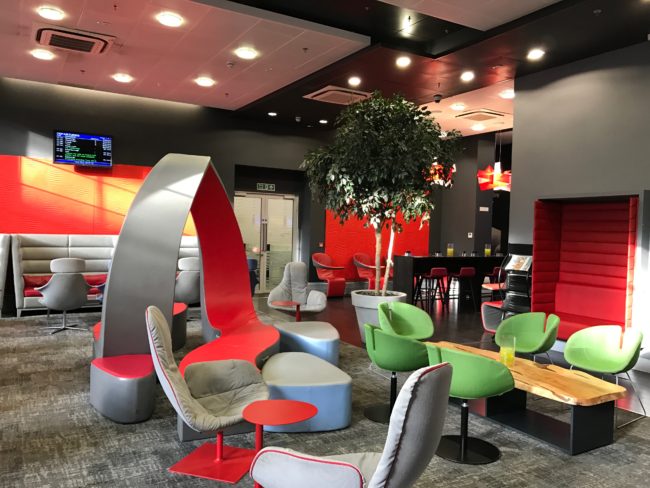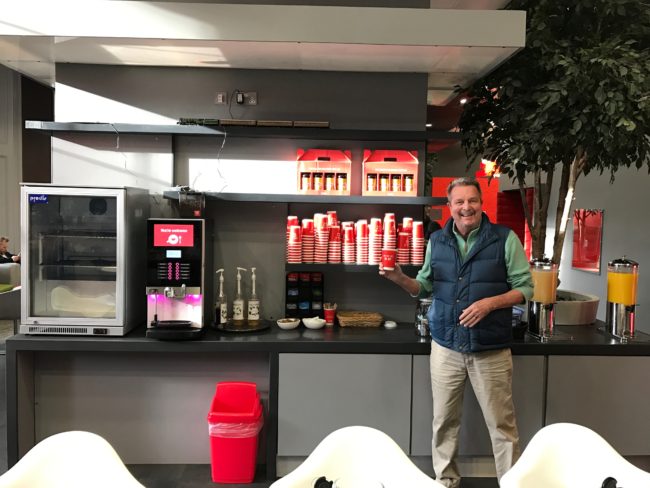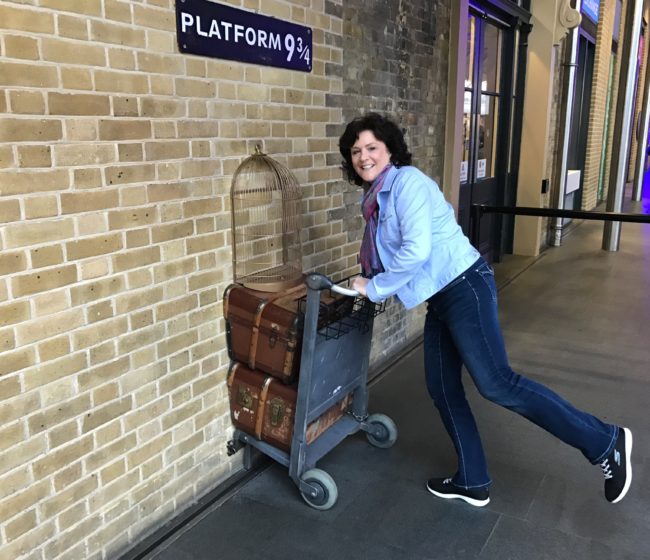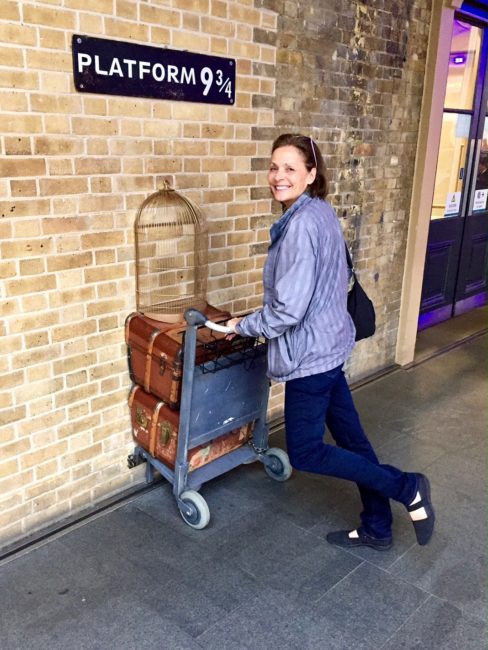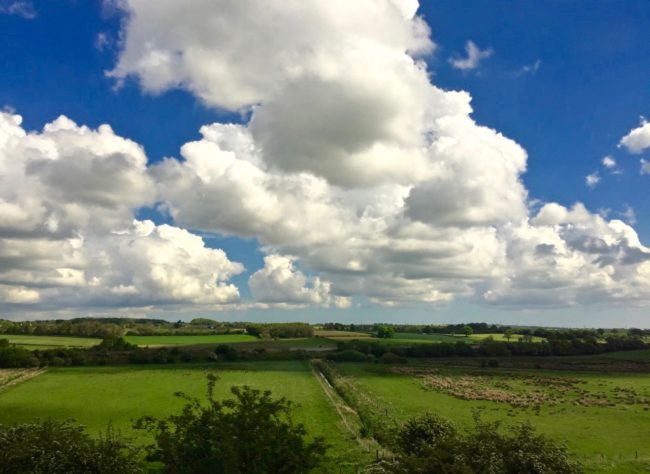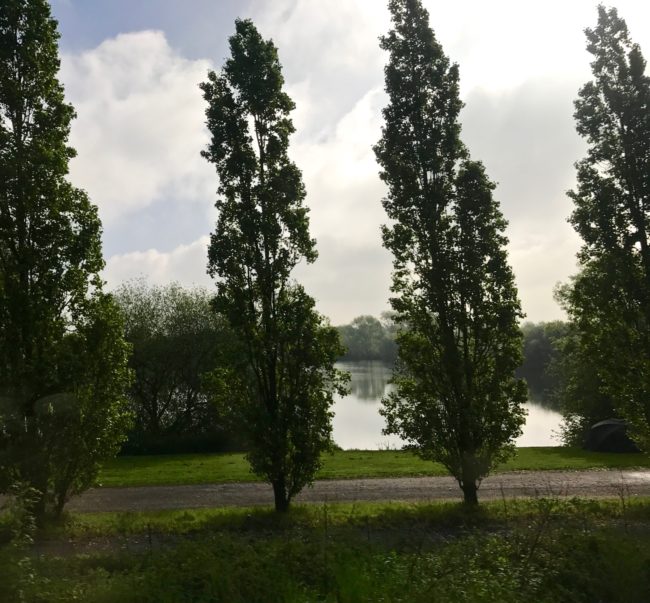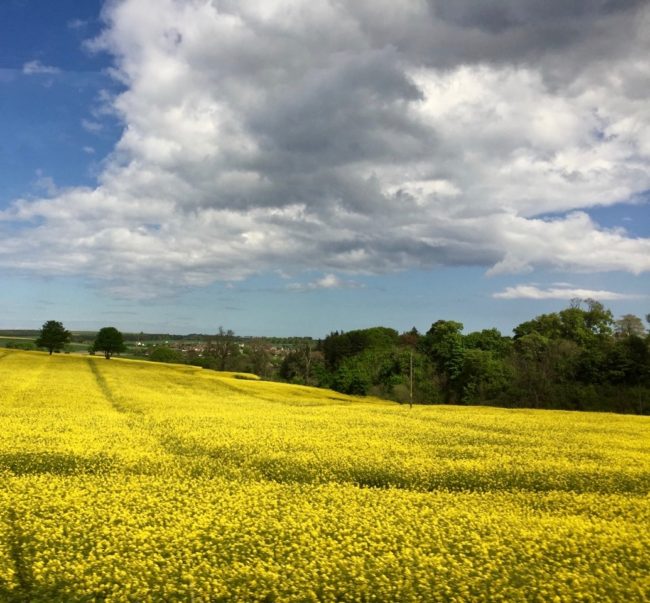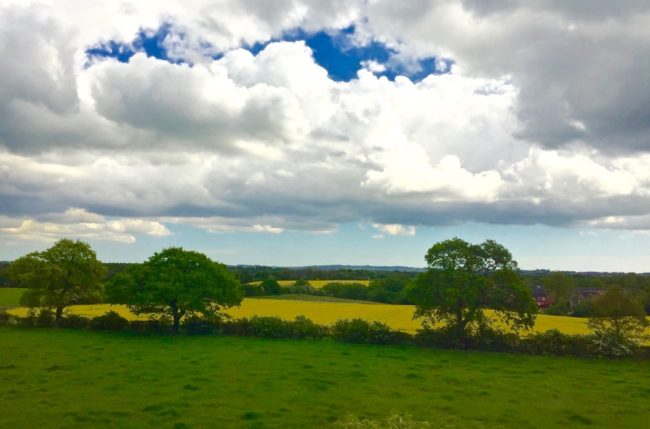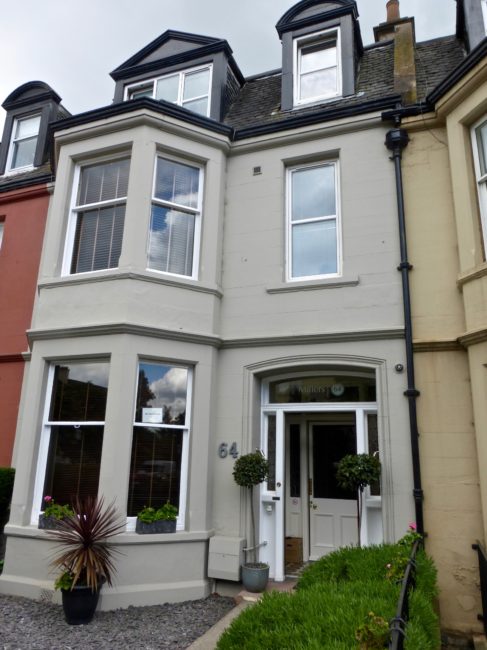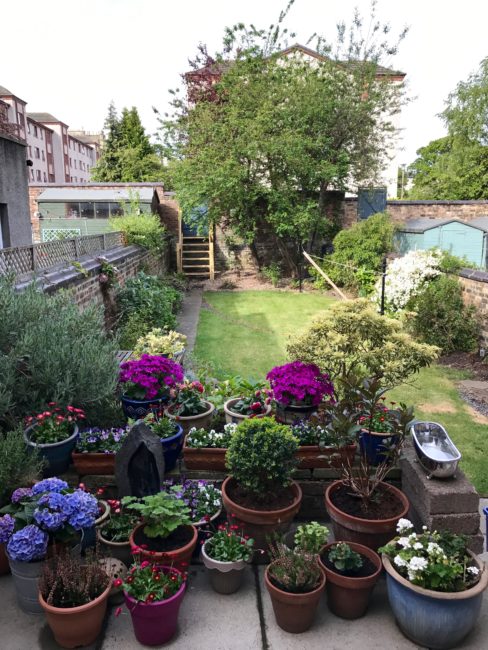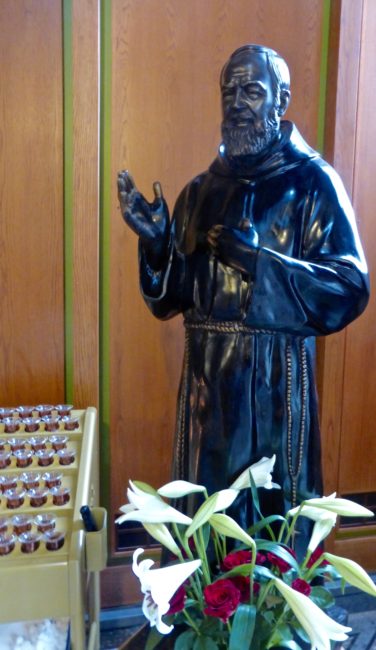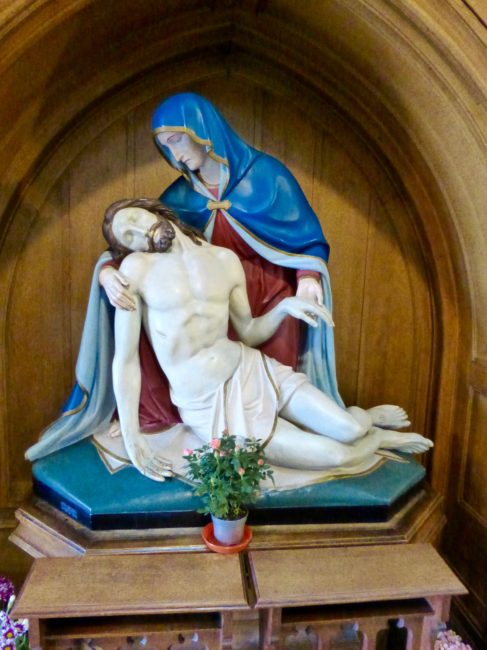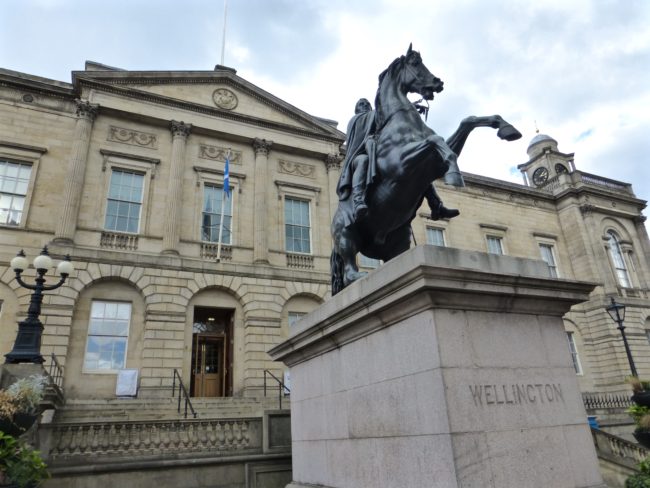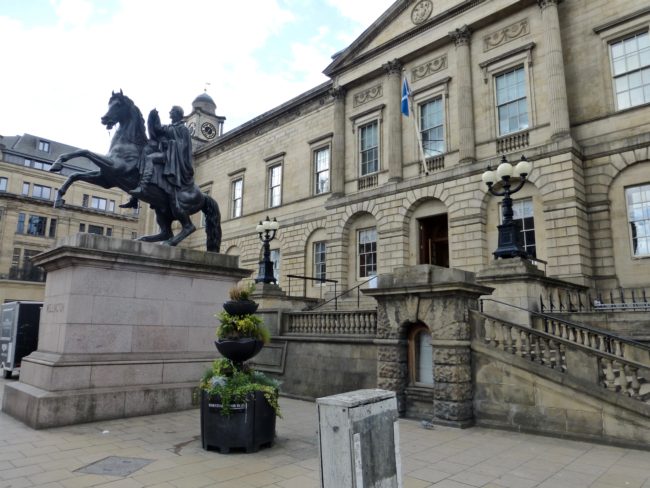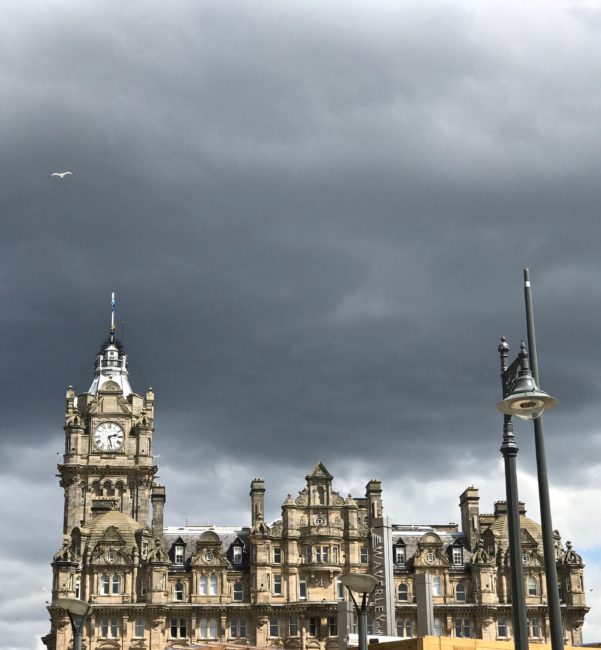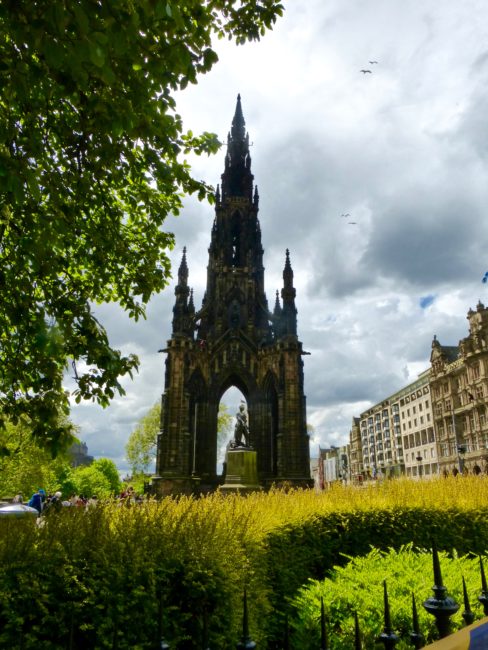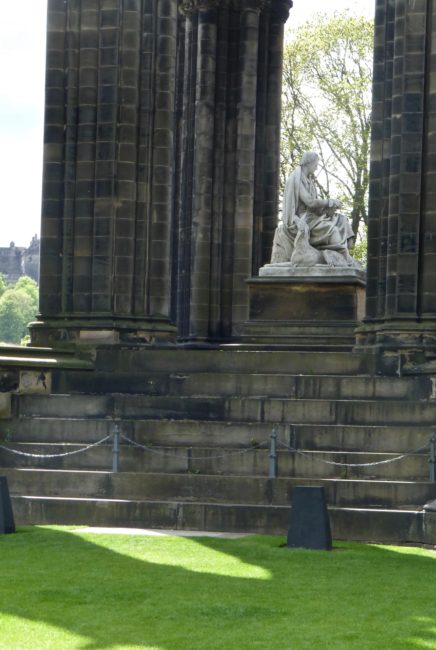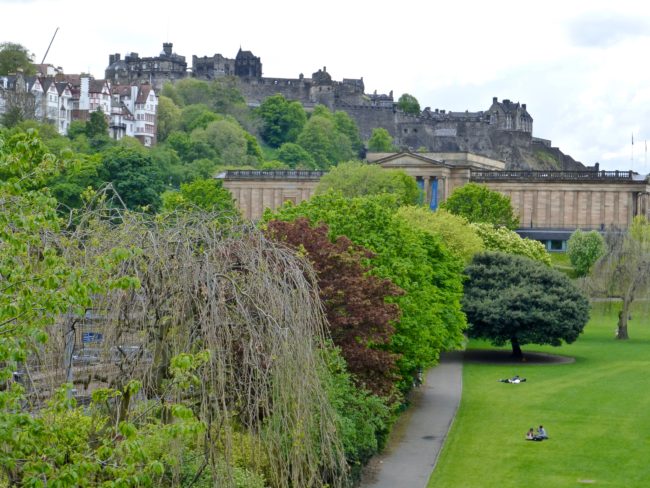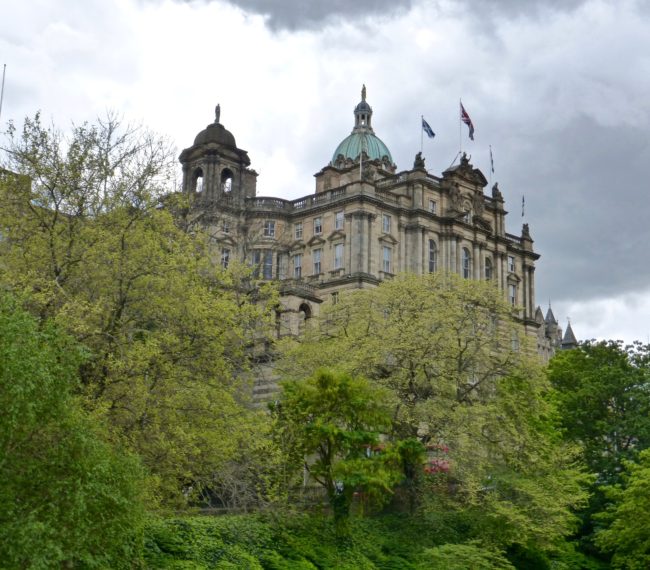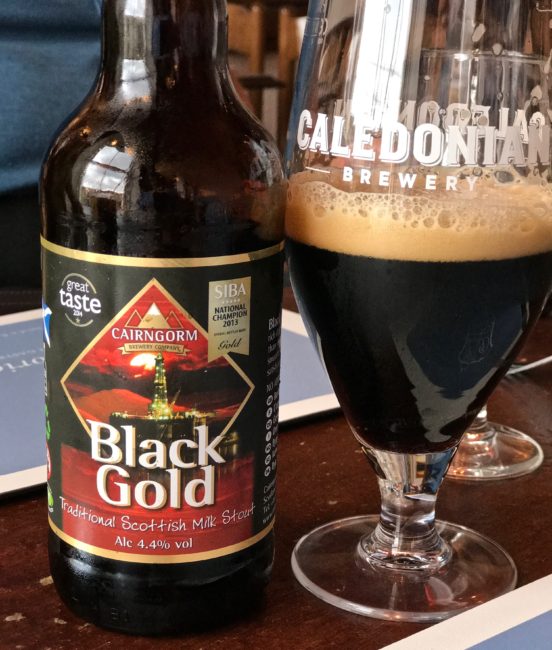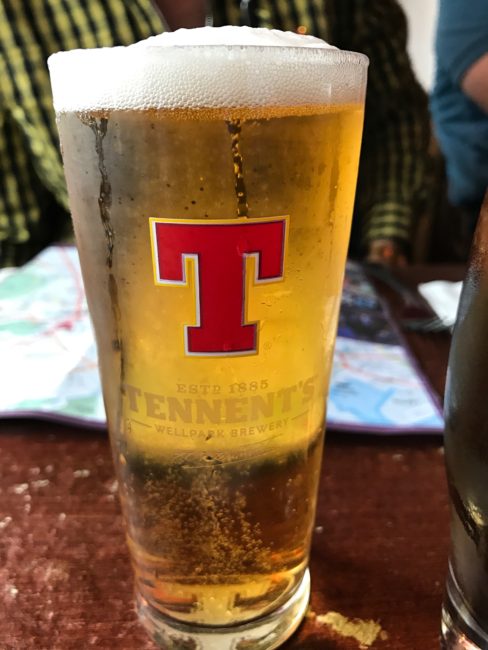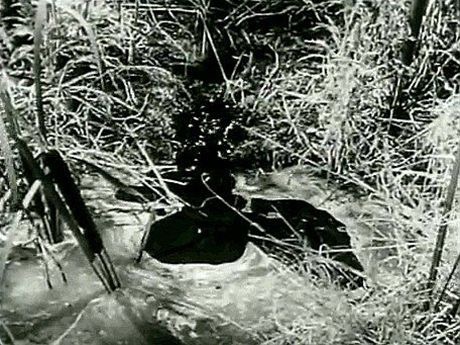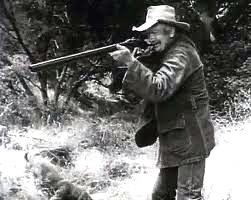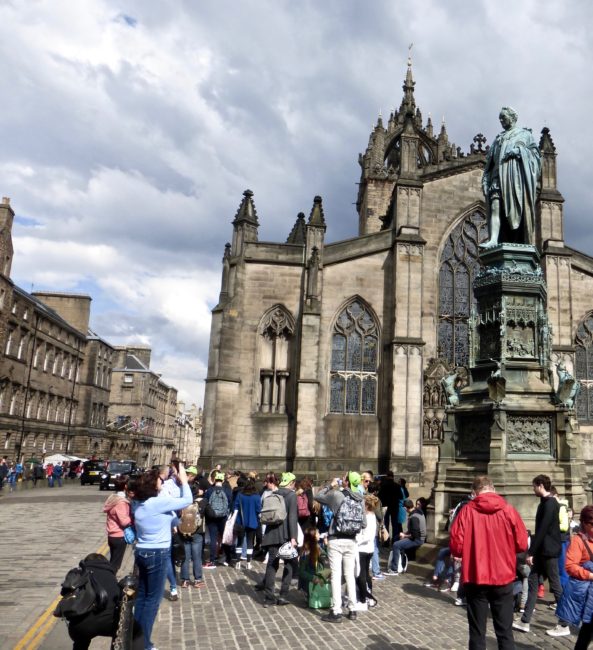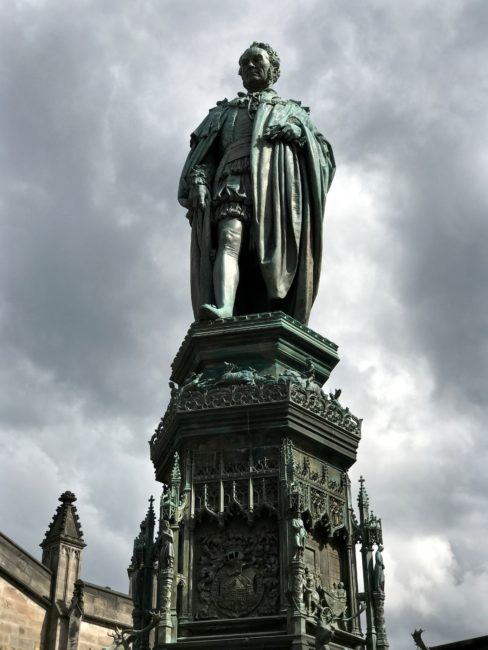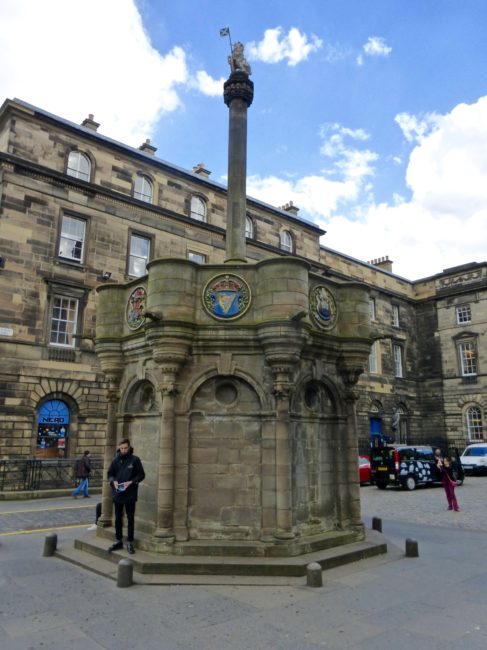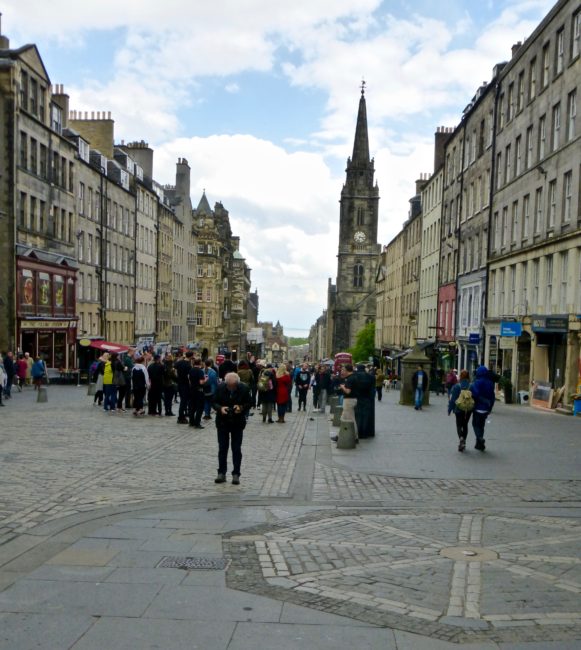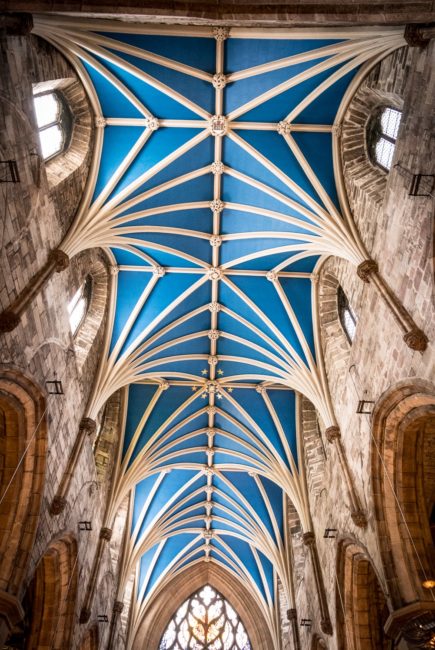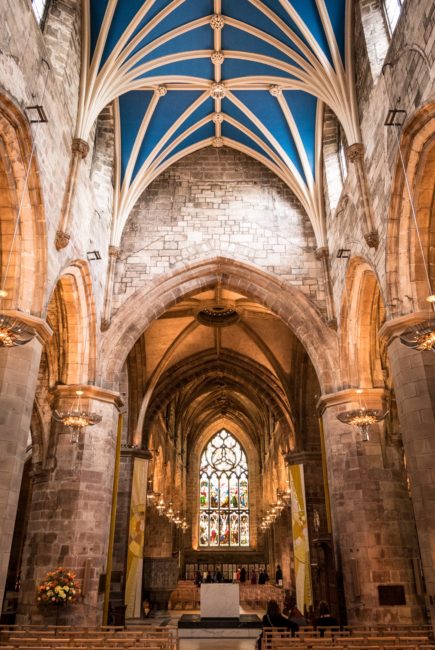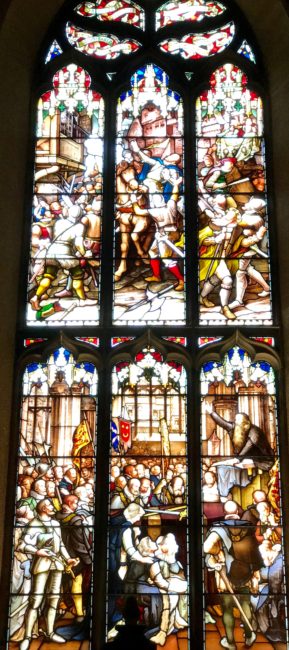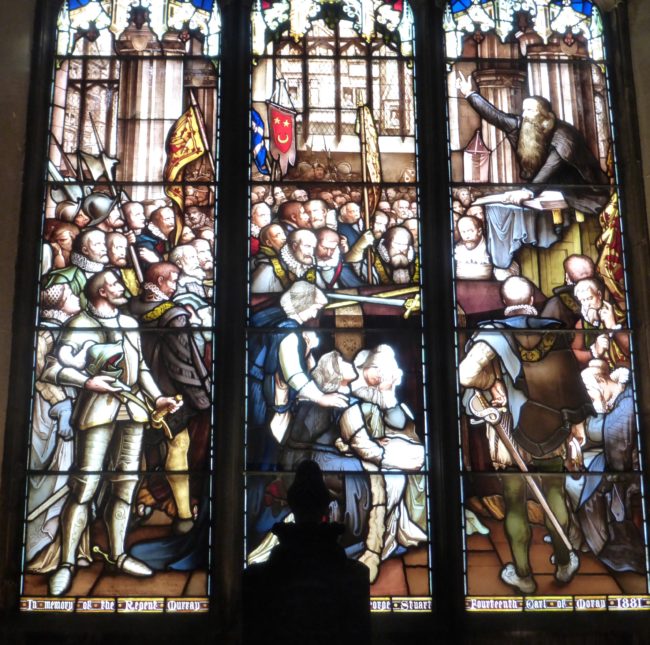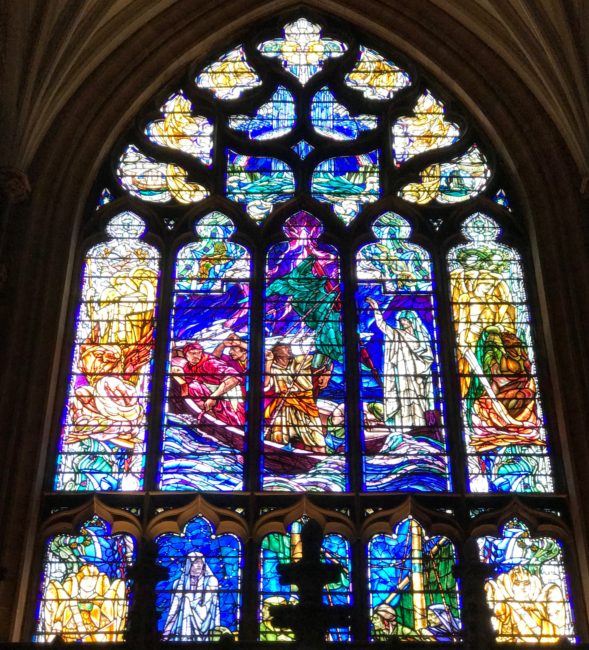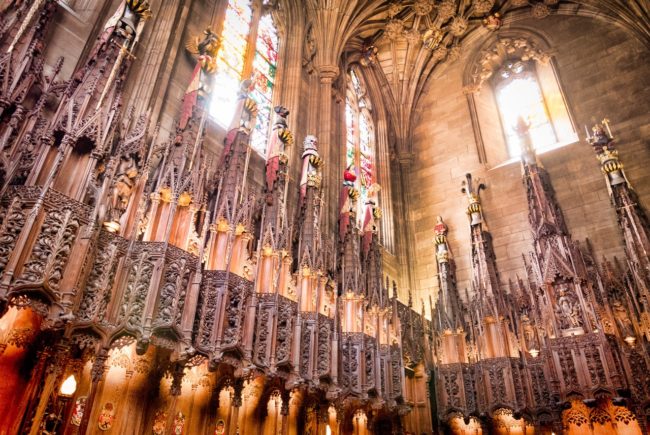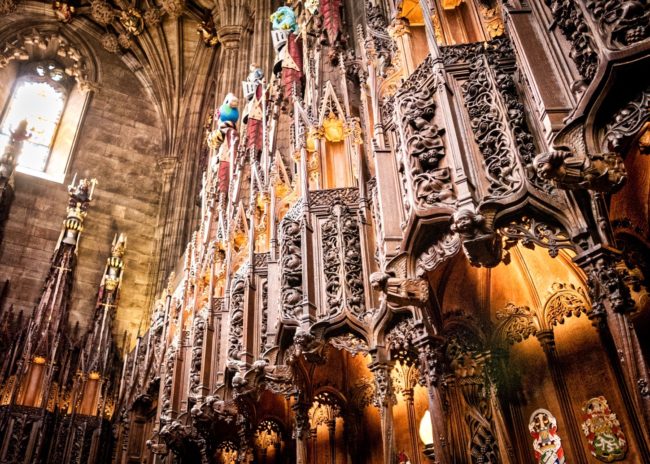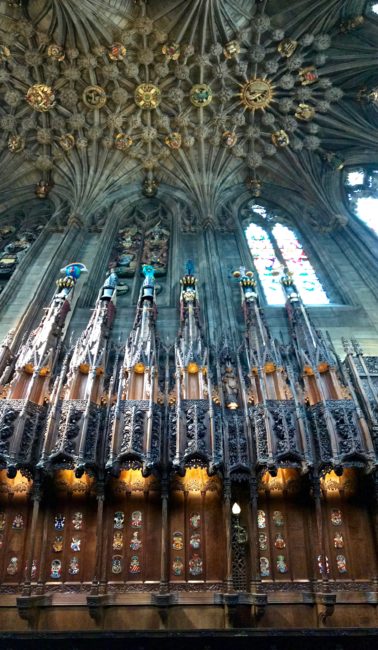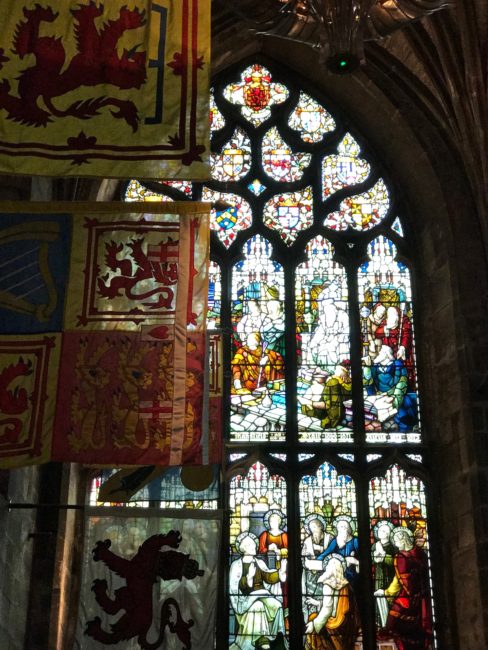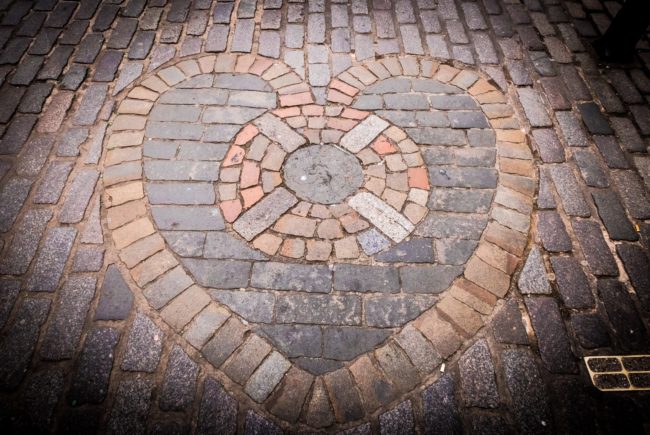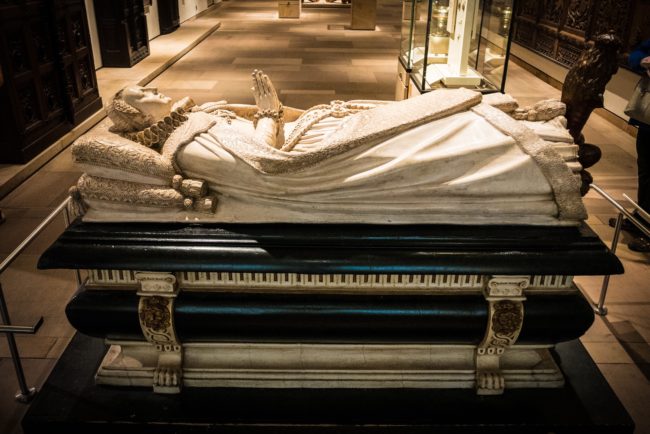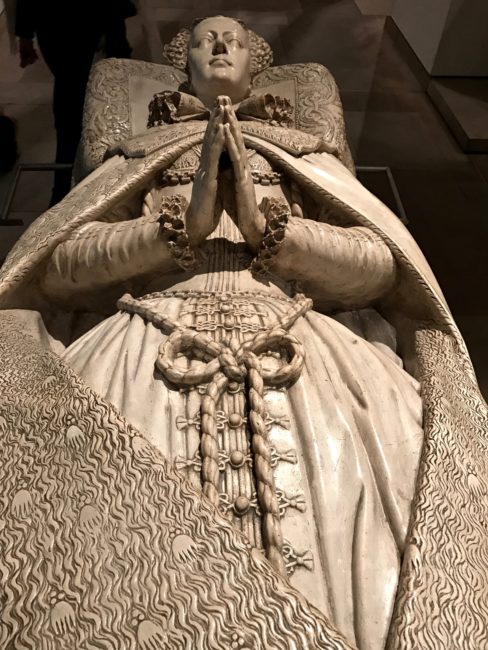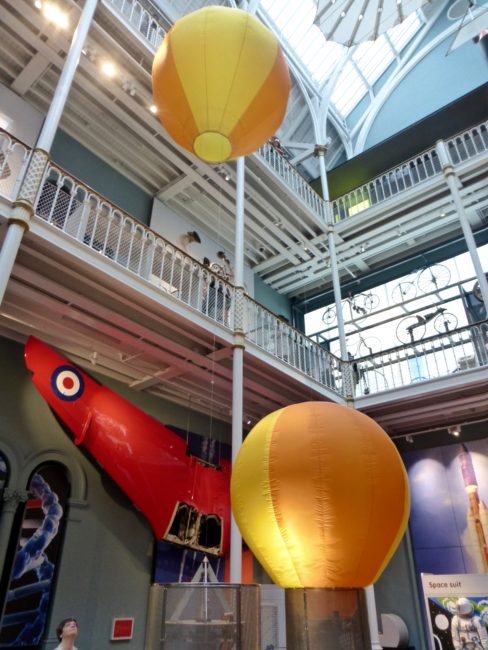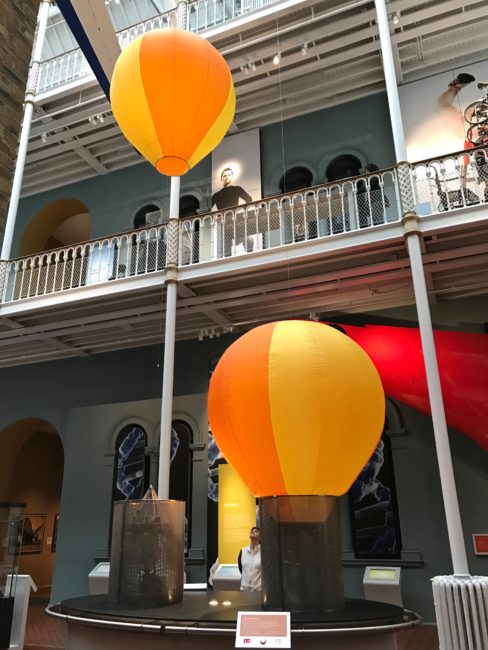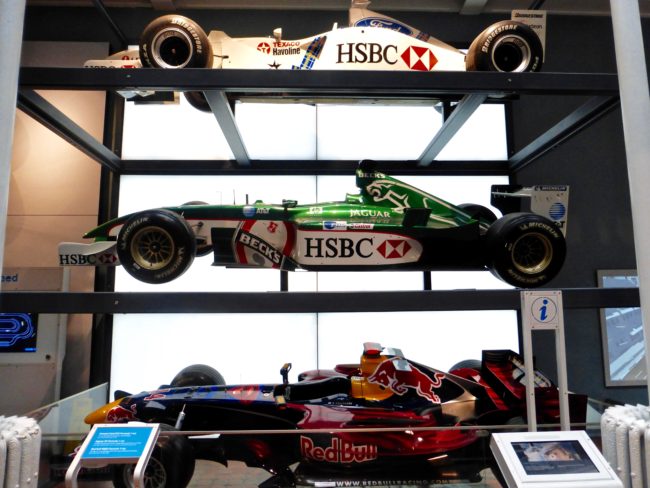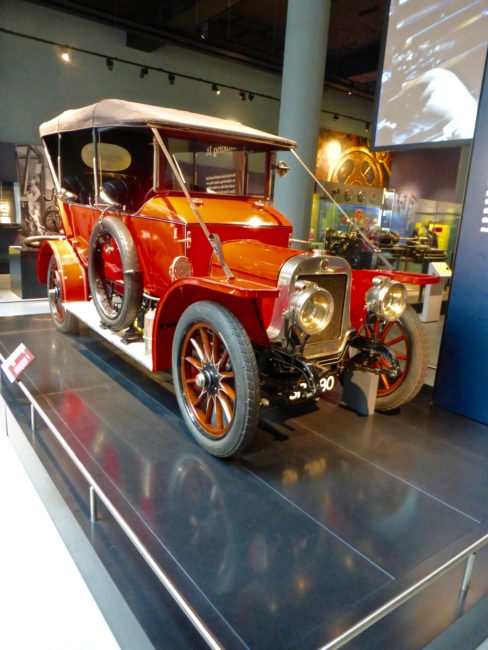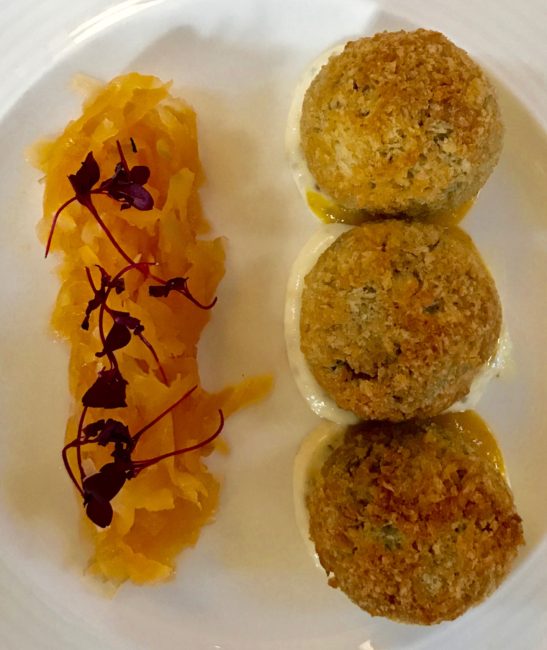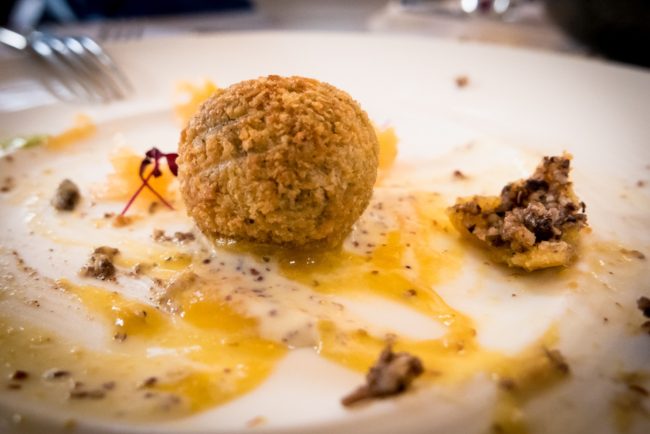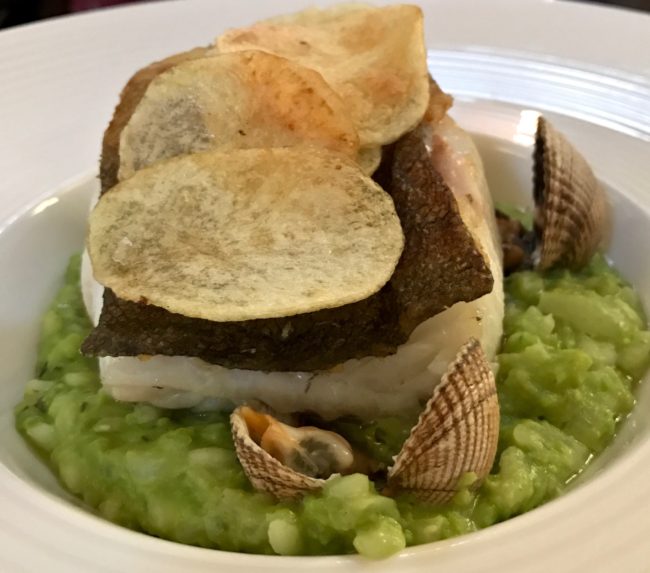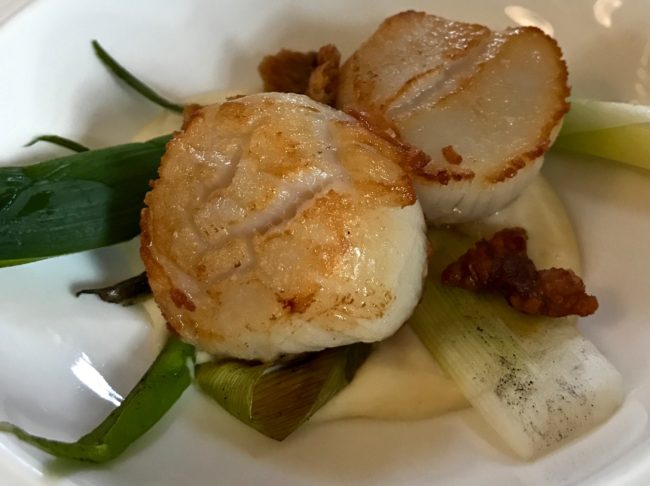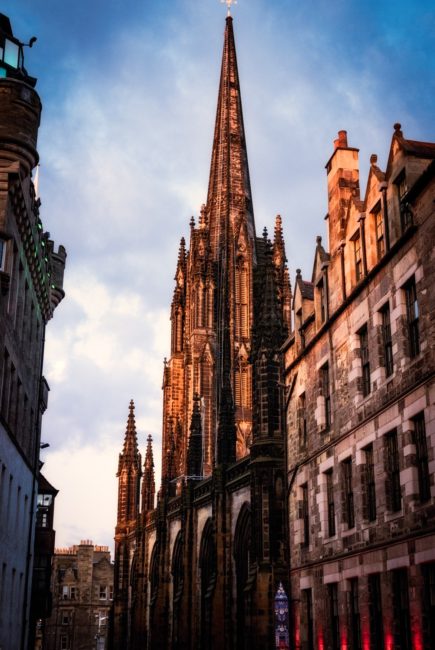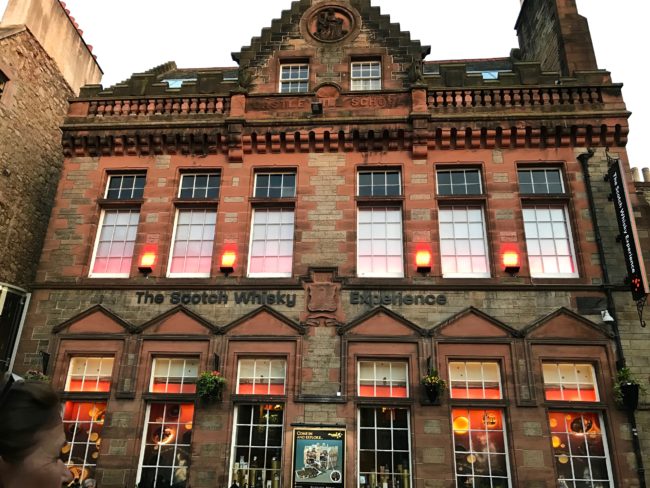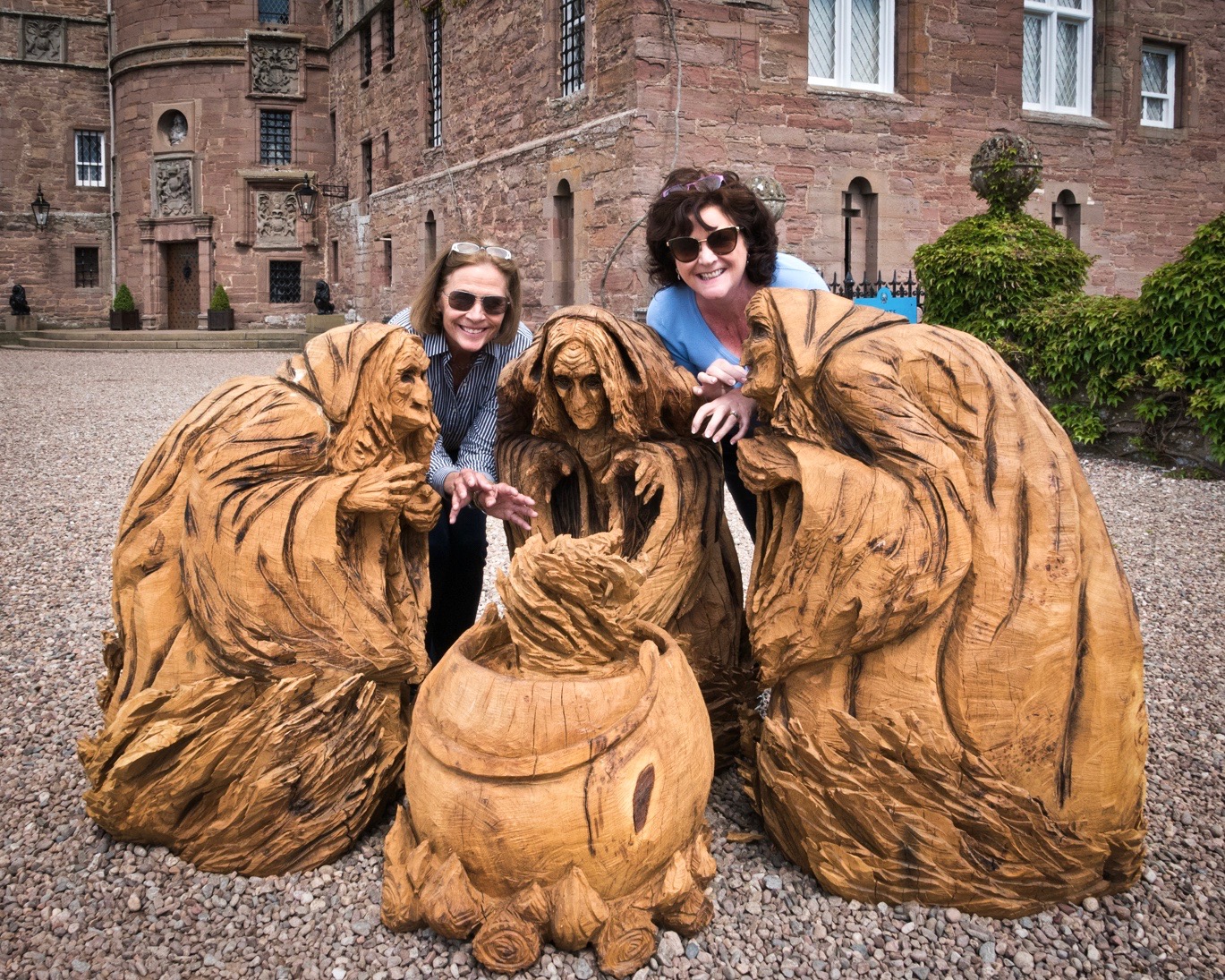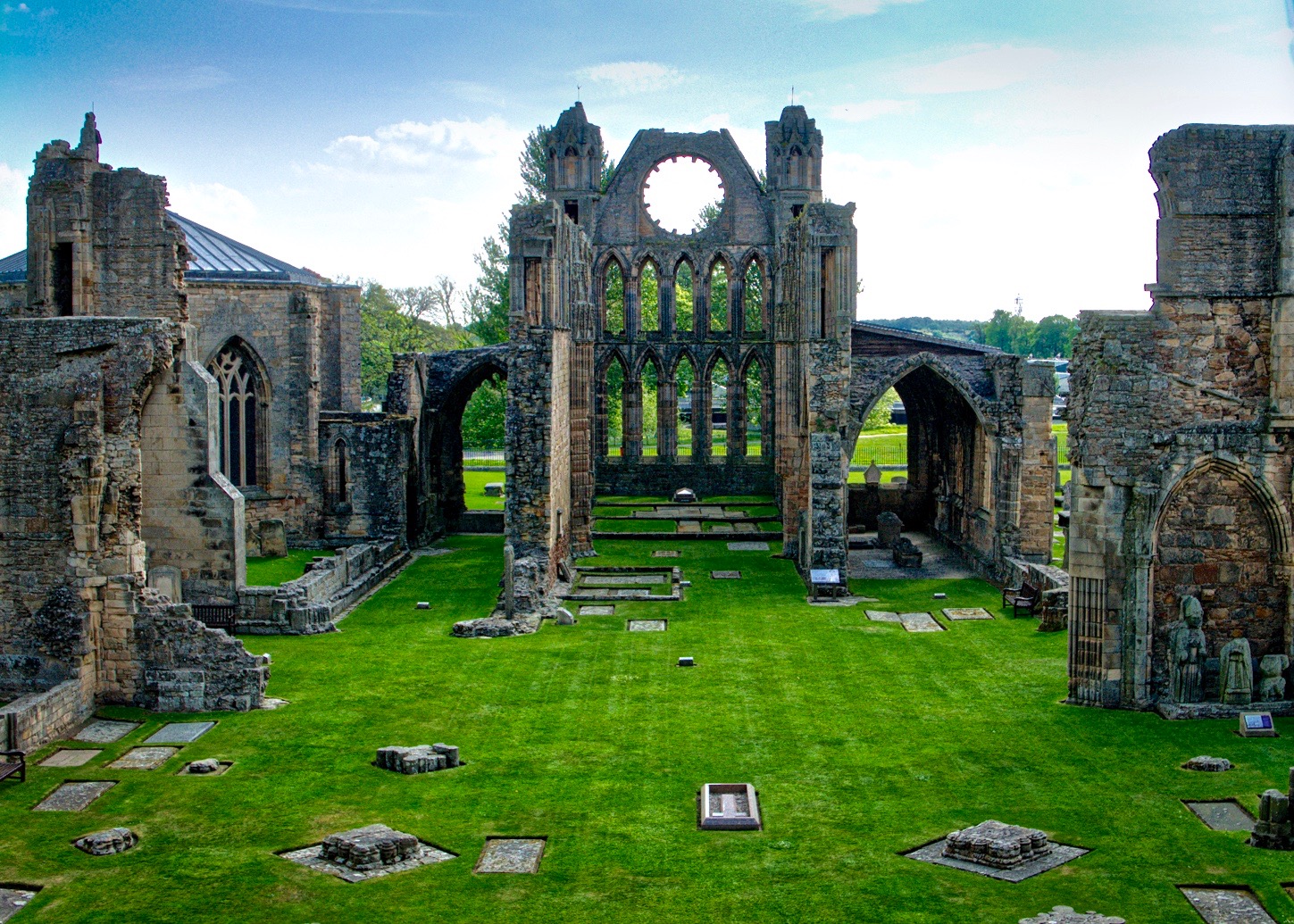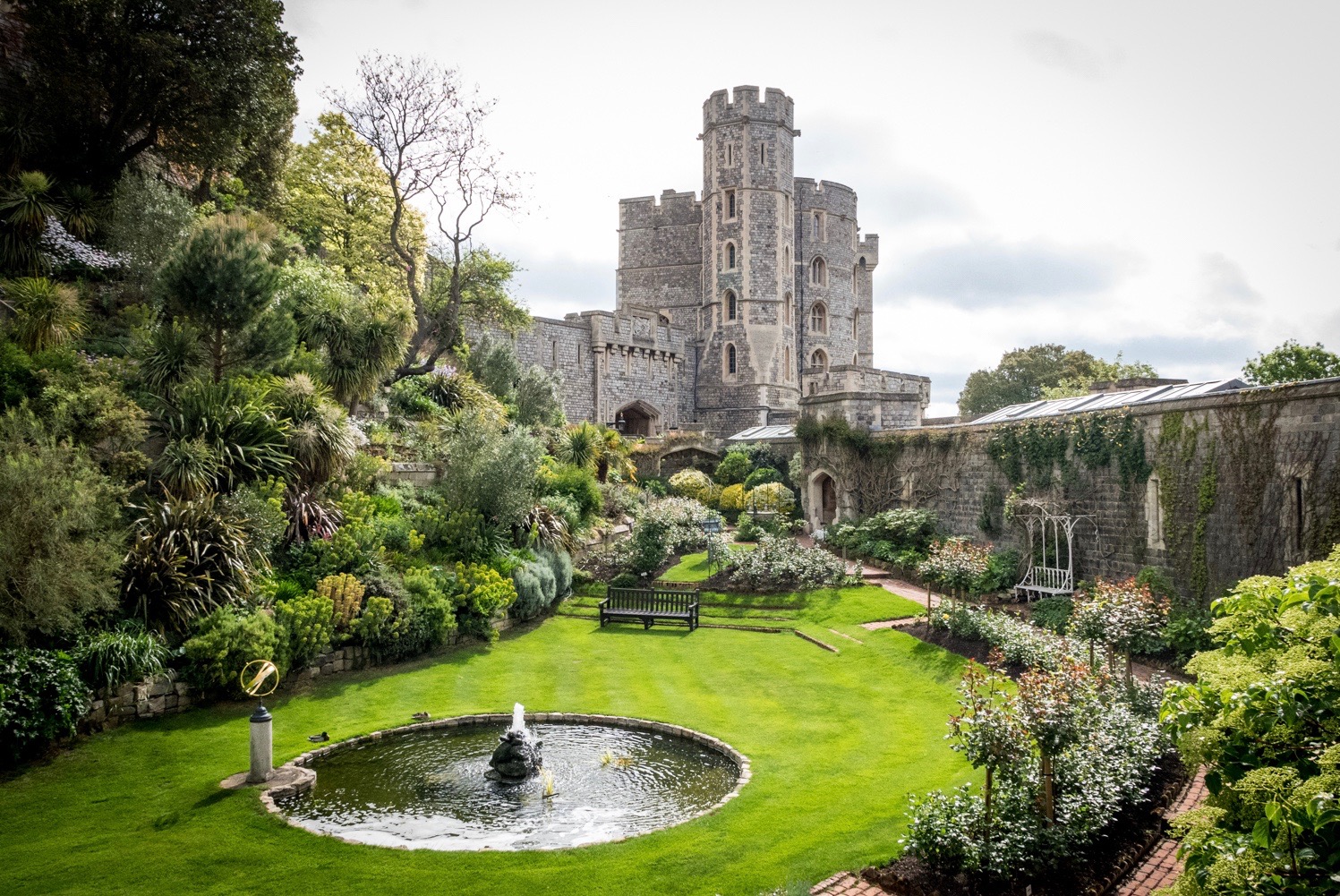
Chapter Three: Windsor Castle, A Crazy Night In London Town & Founding Fathers Visit
July 10, 2017
Chapter Five: Exploring Edinburgh’s Royal Mile
July 22, 2017
MaiTaiTom Gets The Royal Treatment…Two Weeks Exploring London and Scotland
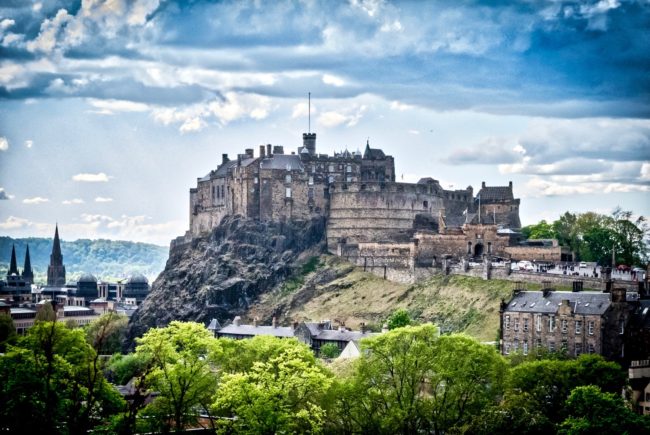 Chapter Four: Enchanting & Exciting Edinburgh
Chapter Four: Enchanting & Exciting Edinburgh
DAY FIVE: Platform 9 3/4, Brexit “BoJo” Encounter, On Track For Edinburgh, How Did He Fit All Our Luggage In Here, It’s Miller’s Time, Exhilarating Edinburgh, Church of Hard Knox, Thistle Put You In Awe, No Cigar, Up On The Roof, Hello Dolly, Where’s The Cannonball, “It’s The Most Scenic Part of Scotland” & The Golden Hour
One terrible thing about my “being late for the train” phobia is that I don’t sleep well the night before a morning trip. Last night was one example.
I had reserved first class tickets on Virgin Trains from London to Edinburgh, and that was a good thing because free food and coffee awaited us at the first class lounge at King’s Cross Station. The lounge opens at 7 a.m., and, of course, we were the first ones inside.
Fifteen minutes after we arrived, there was a security sweep of the lounge. Tracy’s notes say there were “explosive dogs,” but fortunately they were actually dogs just looking for explosives.
At first, I was concerned we had been recognized as the “hard partying Americans” from Tuesday night, however in a few minutes Kim recognized one in the group of individuals who had entered. “Hey, look who’s here…Boris Johnson. Yes, the controversial ex-mayor of London and Brexit proponent walked into the Virgin Lounge complete with a full entourage. Described once by the New York Times as “chronically disheveled,” Bojo did not disappoint. His hair looked as if he had just escaped a tornado (photo from Evening Standard).
Platform 9 3/4
Still with time before our train departed, Mary and Tracy said they wanted to go to Platform 9 3/4, and I had no idea what they were talking about. You Harry Potter fans know this as the spot between Platforms 9 and 10 at King’s Cross Station where the Hogwart’s School of Witchcraft and Wizardry students board the Hogwart’s Express by running toward and wall and disappearing behind it. King’s Cross Station placed a Platform 9 ¾ sign up so fans could have their photos taken. There must be quite a line during the day, because they were setting up rows for people to queue and pay for their photo. Since it was so early, Mary and Tracy just walked over and had their photos taken. Luckily they didn’t disappear into the wall.
On Track for Edinburgh
On board our 8 a.m. train to Edinburgh (4 hours & 19 minutes), our breakfast choices included English breakfast, bacon rolls, porridge with bananas & maple syrup, along with assorted pastries and yogurt. Tracy asked, “What is the bacon roll?” Our server replied, “Bacon in a roll with brown sauce.” Tracy then asked, “What is brown sauce?” Our server replied, “Sauce that is brown.” Before this turned into an Abbott & Costello routine, someone nearby mentioned that it was similar to Worcestershire sauce.
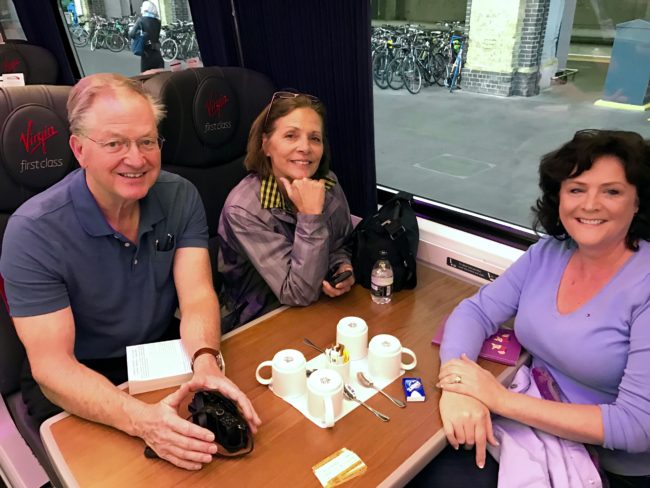 Being sleep deprived, I also took advantage of the bottomless coffee being offered.
Being sleep deprived, I also took advantage of the bottomless coffee being offered.
The scenery along the way was picturesque, especially after we stopped in York.
We sped past Newcastle (not even time to ask for a brown ale) and its Queen Elizabeth II Metro Bridge over the River Tyne.
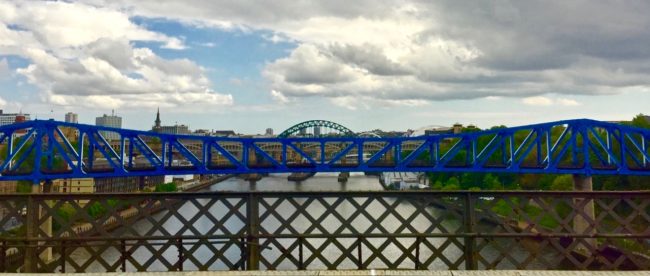 Flowers were blooming and we were already wild about Scotland.
Flowers were blooming and we were already wild about Scotland.
We zipped along the coast and actually hit Edinburgh five minutes ahead of schedule. We hurried outside to hail a taxi.
When the taxi driver in the queue arrived, we said, “I don’t think this car is big enough.” We were wrong. Somehow this guy was able to pack all our luggage in the trunk and back seat, and we still had room to breath. It was a clown car of luggage and people. He drove us toward our b&b of the next four nights. Our personable taxi driver was both humorous and philosophical. He joked about how long it was taking to do all the construction we witnessed on our drive, but also talked about his experience as a Muslim.
Born in Edinburgh, he is married with kids. He said one of the highlights of his life was his two-month trip with his family to the U.S. West Coast, Las Vegas and New York City. He said he has experienced his share of discrimination (both at home and in the U.S.), but has learned to deal with it in a positive manner. He said he dreams of returning one day. He dropped us at our b&b, and we chatted for a while in front. It was both an entertaining and enlightening experience to share his taxi.
Millers 64
We were now standing in front of our new home, Millers64 (64 Pilrig Street). I knew when I booked this b&b it was not in the heart of the action, but as it turned out, we loved it here, and the walk into town is only about 20 minutes, plus the cab rides are cheap (there’s also a bus stop in front…#11…but we always walked or cabbed).
(MaiTaiTomTom addition…October 2017 – Millers64 recently won the the Food and Travel Magazine Best B&B in the U.K. Award)
We were greeted by our host, Louise (who co-owns this inn with sister Shona), who could not have been nicer or more helpful during our stay (more on that as we go). A charming Victorian house, Millers64 has just two rooms (both on the 1st floor, which is the second floor in the U.S.), both nicely sized with walk-in showers, and she also provides a full Scottish breakfast (among other things). We chatted with Louise for a while, and she told us that they purchased the house ten years ago (more on Louise and this wonderful family later…including her mum’s jam). It also has a lovely garden where we would share some afternoon cheer later in the weekend.
Louise had e-mailed me a ton of Edinburgh info before we left, so we had already made some dinner reservations, and shortly after we arrived, armed with walking directions from Louise (it’s very easy), off we strolled toward the heart of Edinburgh.
St. Mary’s Cathedral
Our first stop along the way was St. Mary’s Cathedral (61 York Place). The first Mass was celebrated in 1814. It became a cathedral in 1886. Little of the original chapel exists today. Pope John Paul II paid a visit in 1982.
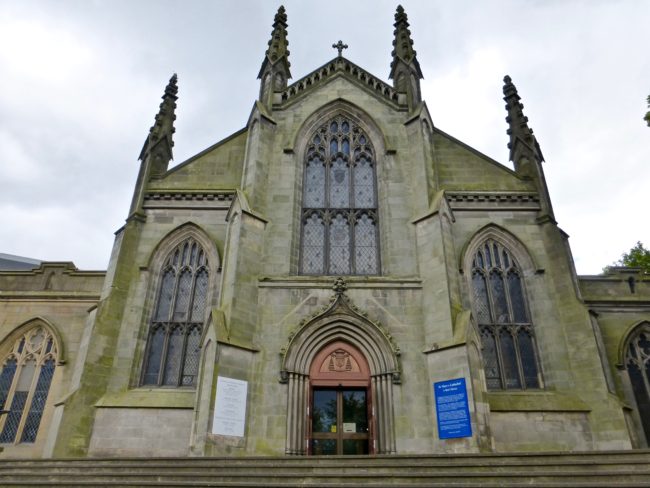 One of “our” Mary’s favorites, Padre Pio greeted us, and we wandered inside for a few minutes.
One of “our” Mary’s favorites, Padre Pio greeted us, and we wandered inside for a few minutes.
It was a beautiful church (“fresco on the arch over the entrance to the sanctuary depicts Mary being crowned Queen of Heaven, attended by angels of all ranks”), but we realized we were in need of food (train food only lasts so long).
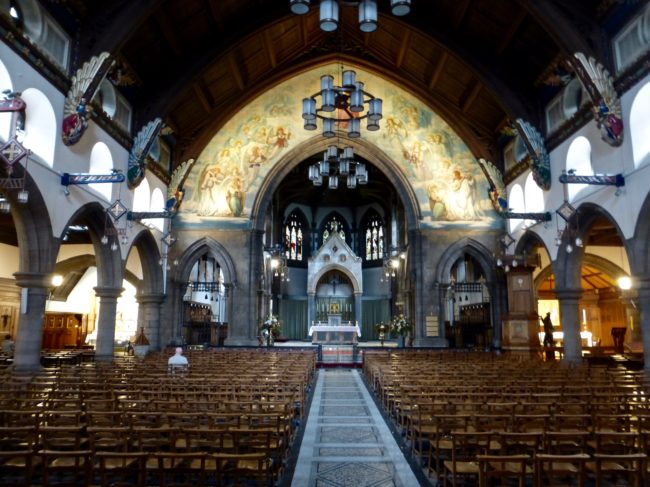 We had to navigate the streets rather carefully, because (as our taxi driver alluded to) there is a lot of construction going on in this neighborhood
We had to navigate the streets rather carefully, because (as our taxi driver alluded to) there is a lot of construction going on in this neighborhood
Duke of Wellington Statue
Our walk took us past The Duke of Wellington Statue (this guy gets around) that stands in front of the Register House. It was unveiled in a patriotic ceremony on June, 18, 1852, the 37th anniversary of Wellington’s victory at Waterloo. The 83-year old Wellington did not attend (he might have been at the ABBA concert), and he met his own Waterloo three months later.
Balmoral Hotel
Next, we stood outside the famed Balmoral Hotel. We had thought about staying here, but it was even more expensive than Mary’s bar bill from the other evening. It first opened in 1902 as the North British Station Hotel and was closed in 1988 for renovations.
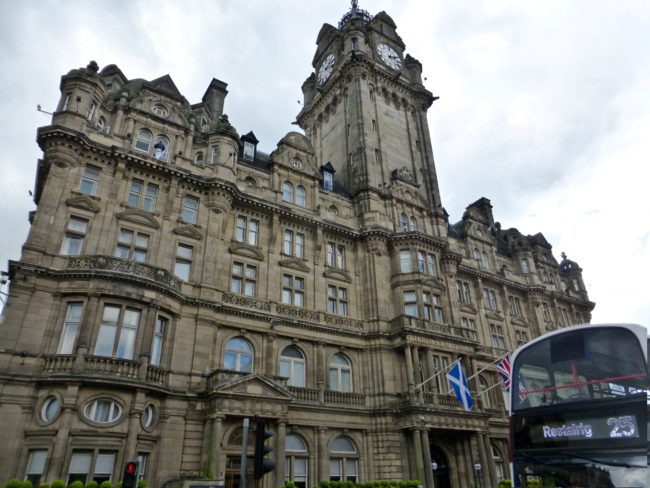 The re-opening in 1991 was hosted by none other than Sean Connery, who I assume had some Bond with this hotel.
The re-opening in 1991 was hosted by none other than Sean Connery, who I assume had some Bond with this hotel.
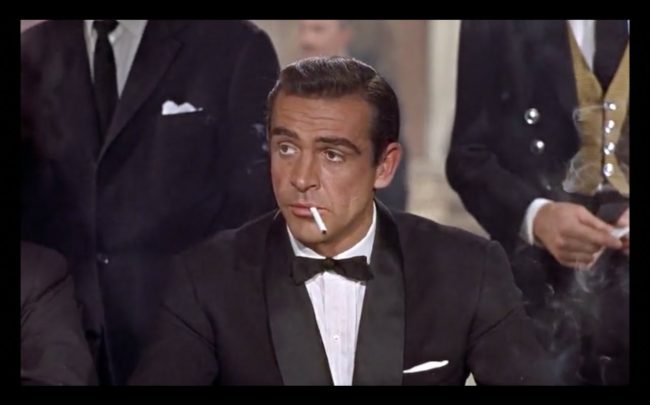 An interesting factoid is that the hotel’s clock is set three minutes ahead so people won’t miss their trains (great idea). It does run on the correct time on New Year’s Eve (Hogmanay).
An interesting factoid is that the hotel’s clock is set three minutes ahead so people won’t miss their trains (great idea). It does run on the correct time on New Year’s Eve (Hogmanay).
The Scott Monument
Edinburgh loves its authors, so it was no surprise that this giant Victorian Gothic structure was constructed to honor Sir Walter Scott, author of Rob Roy (I also enjoy his cocktail) and Ivanhoe. It is the largest monument to a writer in the entire world. The Scott Monument was completed in 1844, and it’ll cost you £5 to walk the 287 steps to the top.
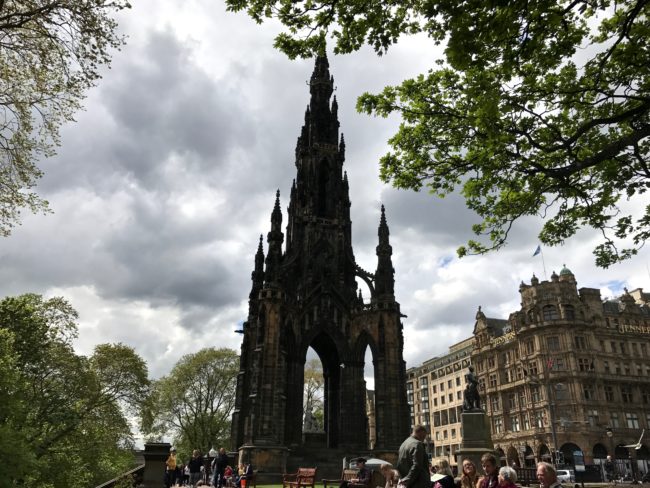 It was designed by George Meikle Kemp, who met a tragic fate. From the Scottsman website, “One dark, foggy evening in March 1844, George M Kemp was making his way back to his home at Jordan Lane, Morningside, when he accidentally stumbled into the Union Canal and drowned. Kemp, 49, had been visiting the offices of one of the monument’s main contractors close to the canal basin on Lothian Road. Following the meeting, he was thought to have blindly made his way through the pea souper across Semple Street towards the main stretch of the canal. He was reported missing for 5 days before his body was finally recovered from the thick mud. Kemp’s hat, still attached by cord to his coat, revealed his whereabouts. But the monument (and the larger than life statue of Scott), lives on.
It was designed by George Meikle Kemp, who met a tragic fate. From the Scottsman website, “One dark, foggy evening in March 1844, George M Kemp was making his way back to his home at Jordan Lane, Morningside, when he accidentally stumbled into the Union Canal and drowned. Kemp, 49, had been visiting the offices of one of the monument’s main contractors close to the canal basin on Lothian Road. Following the meeting, he was thought to have blindly made his way through the pea souper across Semple Street towards the main stretch of the canal. He was reported missing for 5 days before his body was finally recovered from the thick mud. Kemp’s hat, still attached by cord to his coat, revealed his whereabouts. But the monument (and the larger than life statue of Scott), lives on.
The Royal Mile
Walking past the Scott Monument, we headed left on The Mound, however, I couldn’t find a starting pitcher. We looked down upon the Princes Street Gardens (and up toward the castle and other cool buildings) as we headed toward the Royal Mile. We’d visit the gardens on a couple of occasions and even rub elbows with royalty there in a few days.
I recalled that on Market Street was the self-proclaimed “Oldest Gastro-Pub in Edinburgh.” It was built in the 17th century, and this is where we decided to have lunch. It wasn’t hard to find a seat at this off hour. Fish & Chips, a beef Carpaccio and a rocket salad with avocados and tomatoes did the trick for our hunger. For some reason, this beer choice….
…made me think of old Jed Clampett and The Beverly Hillbillies…“Black Gold! Texas Tea!” OK, it was close.
St. Giles Cathedral
Satiated, we finally made our way to the Royal Mile, which was royally crowded in spots, although tomorrow we’d see some real crowds. The Royal Mile encompasses five streets from Edinburgh Castle (Castlehill, Lawnmarket, High Street, Cannongate, and Abbey Strand which leads to Holyrood Palace and is actually a little longer than a mile. We would walk the entirety of the Royal Mile tomorrow, so today we concentrated on the incredible St. Giles Cathedral.
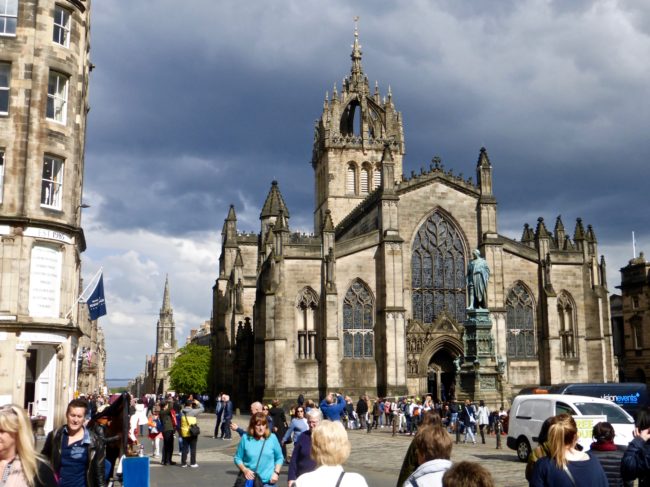 First, we saw the large statue of economist, philosopher, and author Adam Smith. The statue of the author of The Wealth of Nations was unveiled on July 4, 2008.
First, we saw the large statue of economist, philosopher, and author Adam Smith. The statue of the author of The Wealth of Nations was unveiled on July 4, 2008.
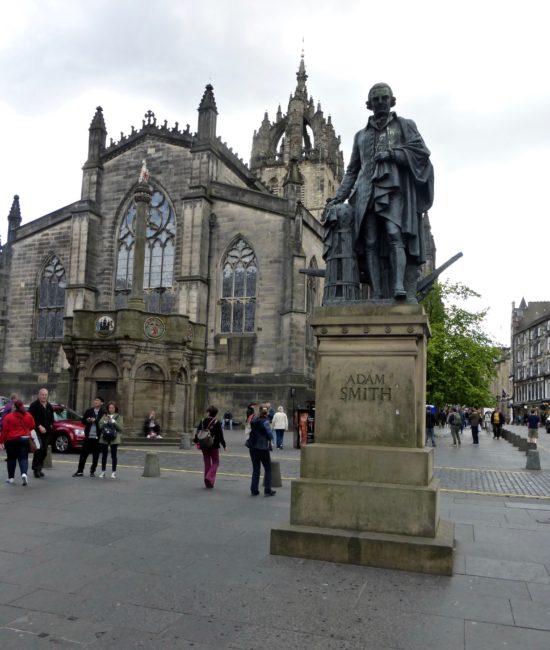 Another statue stands outside St. Giles Cathedral, the Statue of Walter Francis Montagu Douglas Scott (1806-1884), the 5th Duke of Buccleuch and the 7th Duke of Queensbury K.G. It was unveiled in Parliament square in February 1888.
Another statue stands outside St. Giles Cathedral, the Statue of Walter Francis Montagu Douglas Scott (1806-1884), the 5th Duke of Buccleuch and the 7th Duke of Queensbury K.G. It was unveiled in Parliament square in February 1888.
Also on Parliament Square stands the Mercat Cross, although not the original. A replacement built in the late 1800s. The Mercat Cross was the traditional site for formal public proclamations and other announcements (plus some hangings and quartering) in Edinburgh, which they still do today (well, not the hangings and quartering). On top you can also see the Royal Unicorn. The original site is a little further down the way (photo on right) and it is marked.
According to legend, “St. Giles had been a seventh-century Greek hermit who lived in the forests near Nîmes, with a tame deer as his only companion. One day the King of the Visigoths was out hunting, and he shot at the deer, only to find it held protectively in the arms of Giles, who had been wounded in the hand by the arrow. The King was impressed by the holy man, returned many times to speak to him, and finally persuaded him to become the abbot of a monastery which he founded for him. Giles was subsequently canonized, becoming the patron saint of lepers, nursing mothers and the lame.”
St. Giles Cathedral is referred to as “the Mother Church for Presbyterianism” and “High Kirk of Edinburgh.” It’s where reformation preacher John Knox gave many a “fiery sermon.” It’s the principal place of worship of the Church of Scotland. In 1560, the Scottish Parliament passed laws getting rid of the Pope’s power in Scotland. The Scottish Lords were determined to make Scotland a Protestant country. Knox and five other men wrote important documents such as the Scots Confession of Faith, explaining the church’s beliefs. Knox became minister in Edinburgh that year. His life up until that point was incredibly interesting, too (I guess I need to start reading about him).
Oh, and that incredible cathedral. St. Giles was founded in the early 12th century and walking through it, there are so many beautiful aspects to this church. To be able to take photographs, you must pay £2 for a permit. I didn’t even get a Presbyterian discount! This is a visually stunning cathedral.
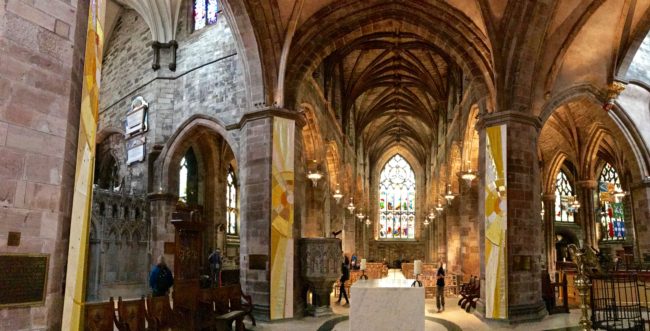 Looking at this beautiful ceiling shot by “Mr. Ceiling” Kim…
Looking at this beautiful ceiling shot by “Mr. Ceiling” Kim…
…you should also look down where you’ll see “The Holy Table,” made of Carrara marble.
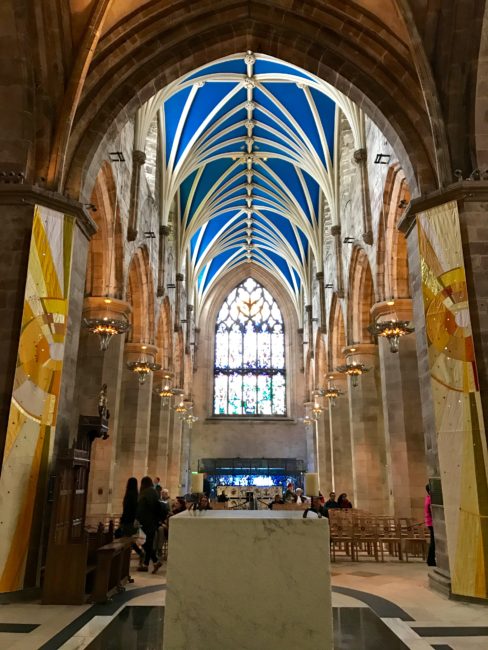 Of course, most of the ceiling’s are gorgeous, and Kim got to take one more of his favorite shots.
Of course, most of the ceiling’s are gorgeous, and Kim got to take one more of his favorite shots.
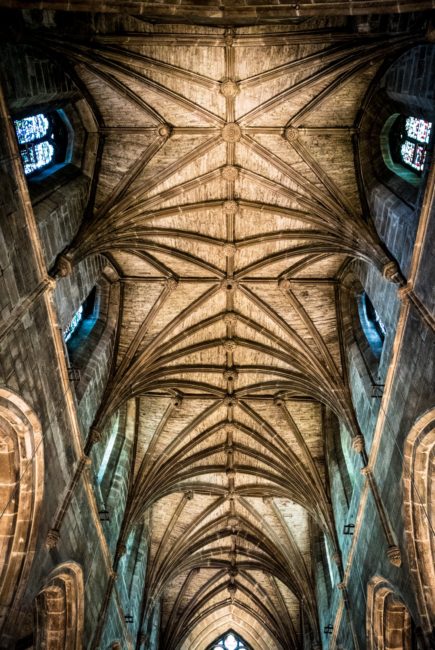 The stained glass windows here are something to behold.
The stained glass windows here are something to behold.
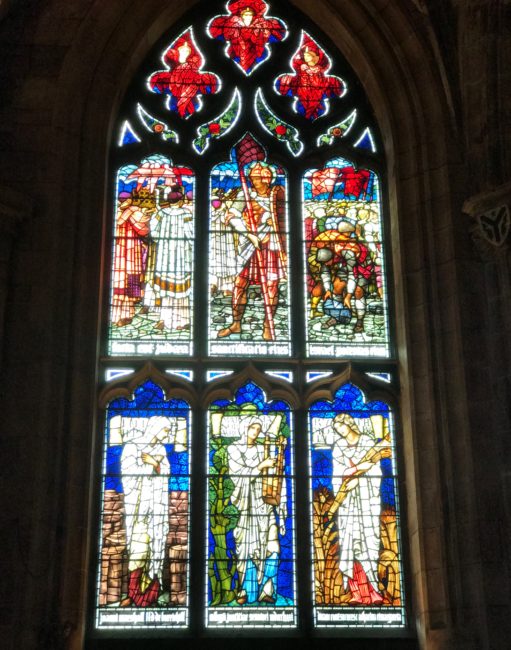 There are a couple that really stood out. One was the Moray window: “After Mary’s forced abdication, Scotland was placed under the government of her illegitimate half-brother, James Stewart, Earl of Moray, a staunch friend of John Knox. After Moray was assassinated in Linlithgow in 1570, he was buried in St Giles’. Knox preached at his funeral. Moray’s monument was destroyed during later alterations, but its original brass plate survived and was fitted to his replica memorial in the Holy Blood Aisle, which also has a stained glass window depicting his death and funeral.” You can see Knox preaching at the funeral.
There are a couple that really stood out. One was the Moray window: “After Mary’s forced abdication, Scotland was placed under the government of her illegitimate half-brother, James Stewart, Earl of Moray, a staunch friend of John Knox. After Moray was assassinated in Linlithgow in 1570, he was buried in St Giles’. Knox preached at his funeral. Moray’s monument was destroyed during later alterations, but its original brass plate survived and was fitted to his replica memorial in the Holy Blood Aisle, which also has a stained glass window depicting his death and funeral.” You can see Knox preaching at the funeral.
Also in St. Giles is a window designed by Douglas Strachan, who hailed from Aberdeenshire.
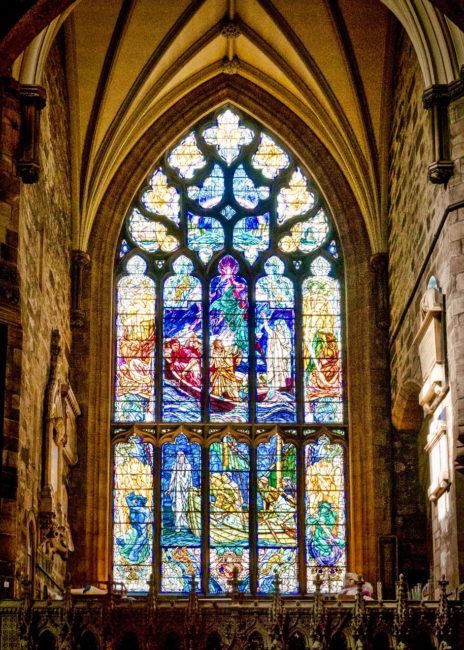 This window depicts four archangels taming the wind gods.
This window depicts four archangels taming the wind gods.
The Thistle Chapel
One of the most gorgeous places in St. Giles Cathedral is The Thistle Chapel. It was designed by Robert Lorimer and finished in 1911. It contains stalls for the 16 knights, the Sovereign’s stall and two Royal stalls. The Thistle Chapel is dedicated to Scotland’s Order of Chivalry, so Kim felt right at home here. The ceiling of the Thistle Chapel is simply astounding. Somewhere up there is an angel playing bagpipes.
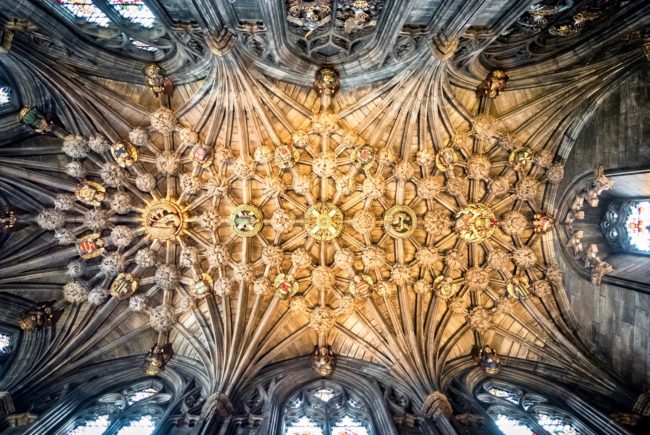 Along the sides of the chapel are the Knights’ stalls, which are “capped by lavishly carved canopies with the helms and crests of the knights rising above.”
Along the sides of the chapel are the Knights’ stalls, which are “capped by lavishly carved canopies with the helms and crests of the knights rising above.”
You really could spend quite a lot of time in St. Giles…and we did.
John Knox (who is buried under Parliament Square) is also represented inside with a statue that was unveiled in 1906. The six-foot tall bronze statue originally stood on a stone pedestal beneath an elaborate Gothic arch until 1965, when it was put in Parliament Square. People feared inclement weather (inclement weather…in Scotland?), so the statue came back inside and now stands on the floor against the north wall of the nave, not far from its original position.
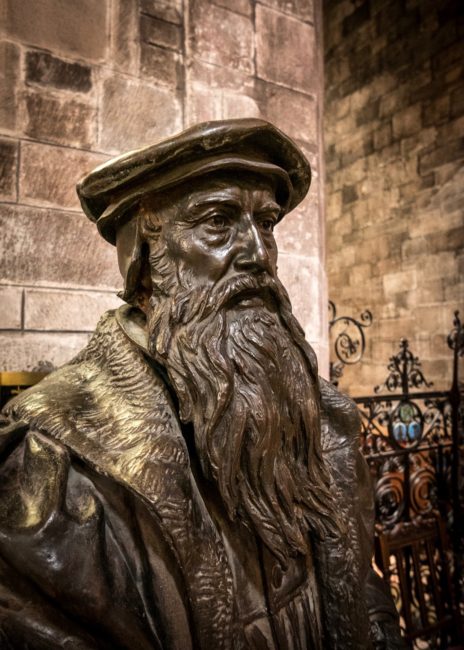 We also found the tomb of Scottish nobleman, poet and soldier James Graham, 1st Marquess of Montrose. In 1638 Montrose joined the party of resistance. He was in many wars, but he finally was captured and hanged in 1650. Graham’s head was topped and it stood on the “prick on the highest stone” of the Old Tolbooth outside St. Giles Cathedral for 11 years (and I thought Braveheart was gory). At some point his body was buried, exhumed and placed inside the cathedral. That’s one tough afterlife.
We also found the tomb of Scottish nobleman, poet and soldier James Graham, 1st Marquess of Montrose. In 1638 Montrose joined the party of resistance. He was in many wars, but he finally was captured and hanged in 1650. Graham’s head was topped and it stood on the “prick on the highest stone” of the Old Tolbooth outside St. Giles Cathedral for 11 years (and I thought Braveheart was gory). At some point his body was buried, exhumed and placed inside the cathedral. That’s one tough afterlife.
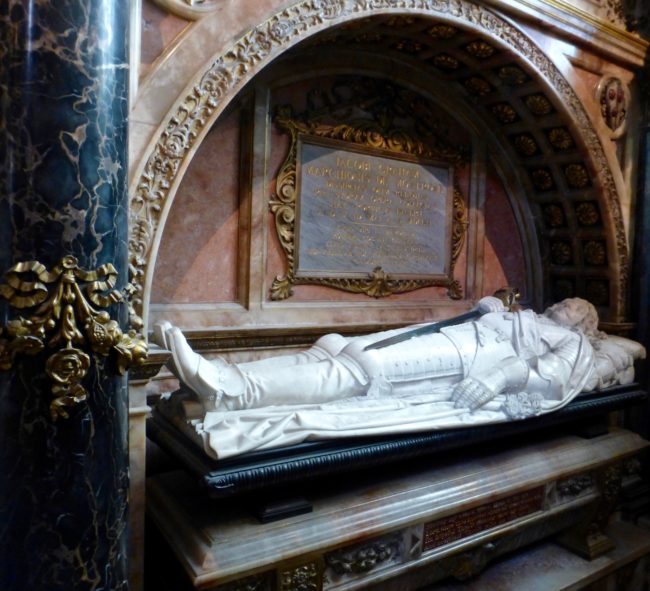 We also checked out this altar carving.
We also checked out this altar carving.
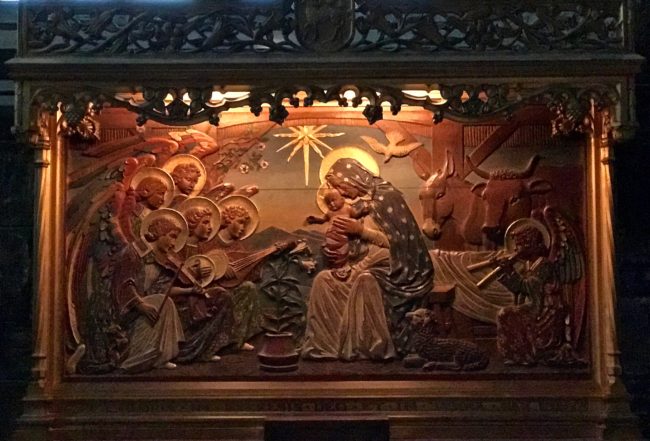 A docent, who had already told us about the Moray stained glass window appeared at another piece we were looking at, and we inquired about a low-relief monument to Robert Louis Stevenson. It had quite a cool back story.
A docent, who had already told us about the Moray stained glass window appeared at another piece we were looking at, and we inquired about a low-relief monument to Robert Louis Stevenson. It had quite a cool back story.
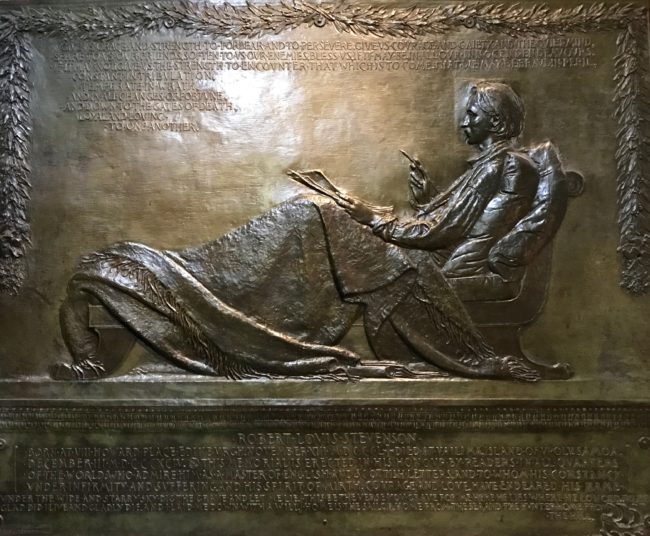 This was made by an American artist who admired the Scot author. The frieze originally had Stevenson holding a cheroot (which I learned was a cylindrical cigar with both ends clipped). The church deemed that to be unsuitable (I assume they said, “It’s close, but no cigar”), so the artist changed it to a quill before he was Kidnapped.
This was made by an American artist who admired the Scot author. The frieze originally had Stevenson holding a cheroot (which I learned was a cylindrical cigar with both ends clipped). The church deemed that to be unsuitable (I assume they said, “It’s close, but no cigar”), so the artist changed it to a quill before he was Kidnapped.
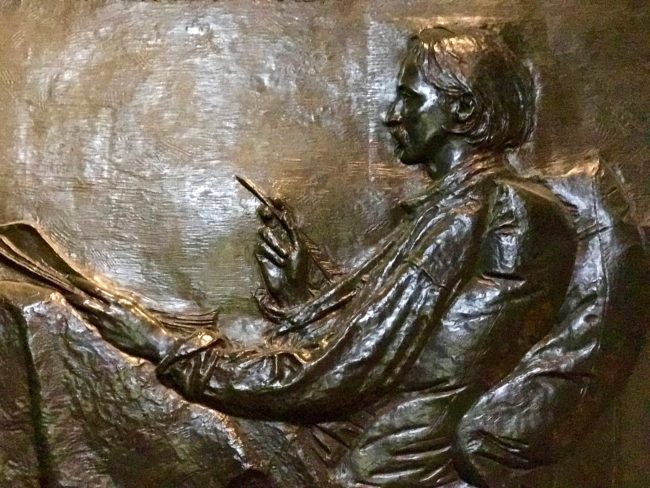 Exiting, there was a statue on the other side of the street that merely said “Hume.” Not named after Hume Cronyn, the statue depicts David Hume, a Scottish philosopher, historian, economist, essayist and close friend of Adam Smith. Hume’s statue would take a rather comical turn when he became a Conehead the following day as we walked the Royal Mile.
Exiting, there was a statue on the other side of the street that merely said “Hume.” Not named after Hume Cronyn, the statue depicts David Hume, a Scottish philosopher, historian, economist, essayist and close friend of Adam Smith. Hume’s statue would take a rather comical turn when he became a Conehead the following day as we walked the Royal Mile.
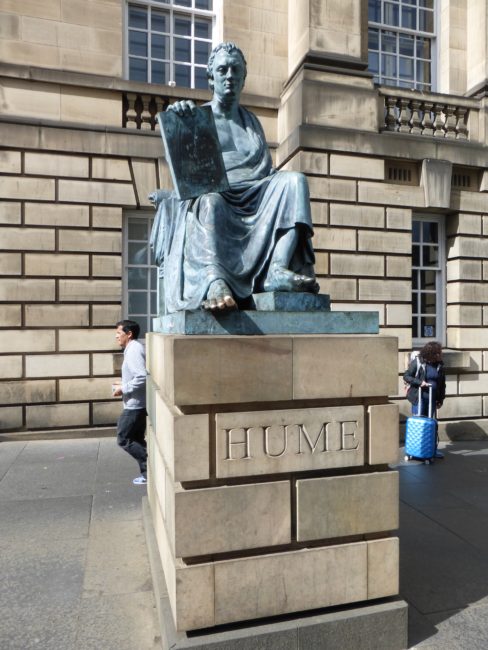 Also near the cathedral is a heart-shaped mosaic in the street appropriately called The Heart of Midlothian. I read, “This represents the Heart of Midlothian and marks the entrance to the old Tolbooth (built around the beginning of the 1400s and demolished in 1817) which served as Edinburgh’s prison, court and municipal offices.” It seems that a lot of executions were held in this spot including William Brodie (more on him and the tavern bearing his name as our weekend progresses).
Also near the cathedral is a heart-shaped mosaic in the street appropriately called The Heart of Midlothian. I read, “This represents the Heart of Midlothian and marks the entrance to the old Tolbooth (built around the beginning of the 1400s and demolished in 1817) which served as Edinburgh’s prison, court and municipal offices.” It seems that a lot of executions were held in this spot including William Brodie (more on him and the tavern bearing his name as our weekend progresses).
National Museum of Scotland
Most people would have gone back to the b&b for a nap by now, but not this intrepid group of crazed tourists. It was on to the National Museum of Scotland on Chambers Street. It’s free to enter.
We had heard that this museum is “one of the Top 10 UK visitor attractions, and in the Top 20 of the most visited museums and galleries in the world.” I don’t know if that’s true, but it was not overly crowded on this afternoon. If you want to learn about Scottish history, this is your place. There are objects linked with “Land, People, Language, and Belief.”Of more historical interest is the tomb of Mary, Queen of Scots, which was cast from the original at Westminster Abbey. The sign stated, “James VI (by the way in England, he is James I) had this elaborate tomb erected, partly to appease his guilt at distancing himself from his mother during his lifetime.”
There were colorful rooms…
…and interesting Otto-mobiles (hey, you have to pay attention from the beginning)…
…before heading to the 7th floor (go to the 5th by elevator and then climb the stairs). From the 7th floor you can get a 360-degree view of Edinburgh.
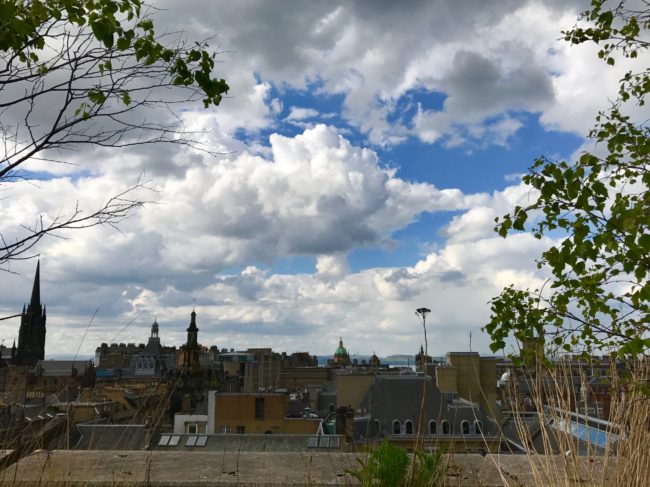 Kim did some fancy editing and made this one look like a painting.
Kim did some fancy editing and made this one look like a painting.
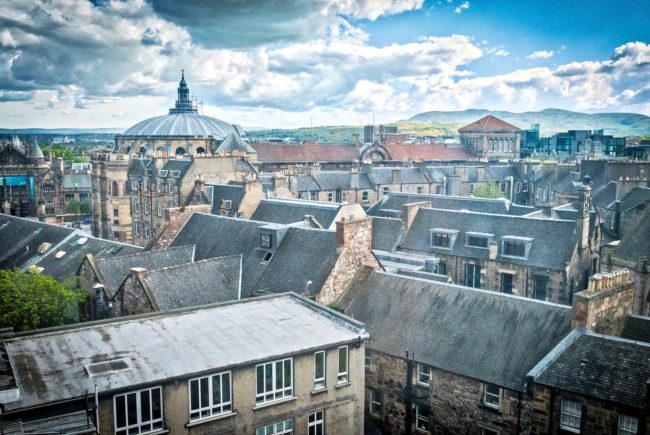 We hung out here for about 15 minutes…
We hung out here for about 15 minutes…
 …but then went back downstairs. We had saved the best for last. The National Museum of Scotland houses the most famous sheep in the world, Dolly. In 1996, Dolly was cloned from one of 277 eggs. She lived until 2003, and she made her way here (with a little help from her friends) to the National Museum of Scotland.
…but then went back downstairs. We had saved the best for last. The National Museum of Scotland houses the most famous sheep in the world, Dolly. In 1996, Dolly was cloned from one of 277 eggs. She lived until 2003, and she made her way here (with a little help from her friends) to the National Museum of Scotland.
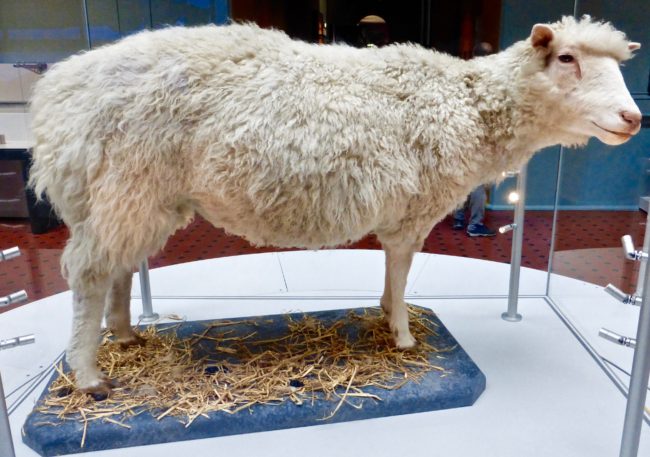 I couldn’t help myself and found myself singing Hello Dolly and Send In The Clones (sorry Sondheim). Feeling sheepish after that, we took it on the lamb.
I couldn’t help myself and found myself singing Hello Dolly and Send In The Clones (sorry Sondheim). Feeling sheepish after that, we took it on the lamb.
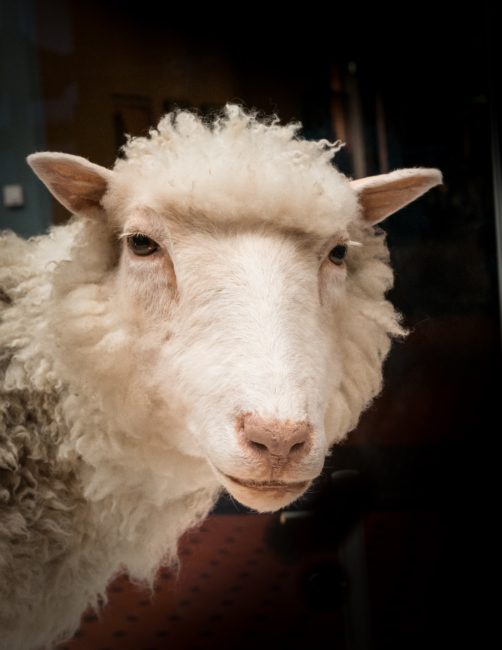 We walked part way to Millers64, but when a taxi stopped at a light near us, we couldn’t resist. We freshened up, told Louise what we had already done (she was exhausted just listening to us), and she called a taxi to pick us up for dinner near the castle.
We walked part way to Millers64, but when a taxi stopped at a light near us, we couldn’t resist. We freshened up, told Louise what we had already done (she was exhausted just listening to us), and she called a taxi to pick us up for dinner near the castle.
Cannonball Restaurant & Bar
Our taxi ride to the Cannonball Restaurant & Bar was a little under £8, a bargain for one couple…a steal for two couples. Somewhere there is supposed to be a cannonball lodged in the bricks, but we never found it. What we did find was quite an enjoyable meal, made even better by their terrific staff. I said I would try their Manhattan with just any bourbon, but the lovely bartender made it, took a taste and didn’t like it, so she made me a Manhattan with the expensive bourbon and charged me the cheaper price. I was liking this place already.
Our young waitress was originally from the Isle of Skye, “the most scenic part of Scotland,” she said. She was also persuasive. She talked us into the Cannonballs, Findlay’s haggis with pickled turnip, Glengoyne 10 year-old whisky and Seville orange marmalade (£7.50). While this is something I wouldn’t eat every day, reports of haggis being awful were debunked here (we’d have an even better one later in the trip).
We left one on the plate, and when we asked one of the other servers (who was from Poland) if he liked Haggis, he answered he had never tried it. So we had him try our last one. His restaurant peeps were amazed he had never tried one before. As you can tell, this is a friendly restaurant.
If that wasn’t enough, Mary decided we should try the asparagus (not my favorite dish), Grilled warm Patullo award winning Scottish asparagus, homemade ricotta with charred spring greens and lemon dressing (£7.50). It was surprisingly good (I only had a small bite).
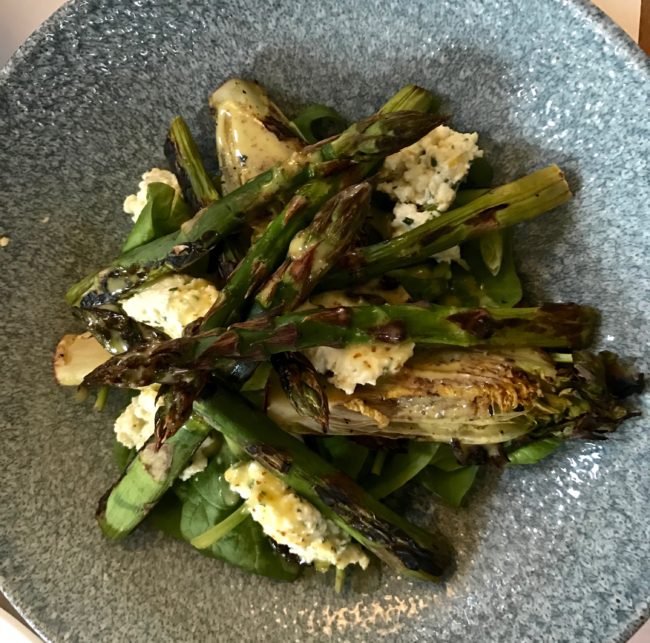 Actually, all our dishes were good, from the sea bass to the scallops…
Actually, all our dishes were good, from the sea bass to the scallops…
…to my “Wow” Spinach & Chili Soup…
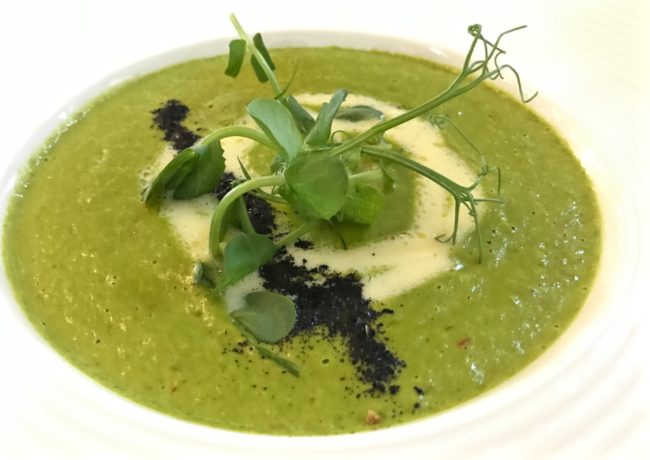 …to marvelous wild mushroom gnocchi.
…to marvelous wild mushroom gnocchi.
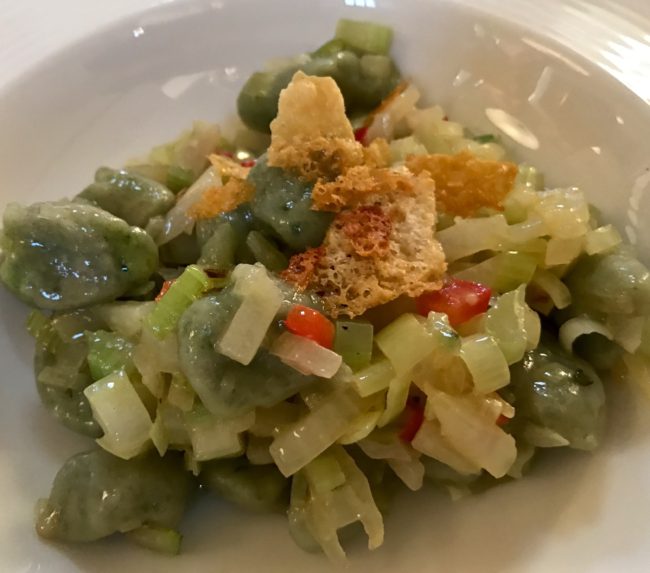 In the end, our (and this is Tracy’s description) “impossibly young, very personable” manager stopped by to see how we liked our dinner. We had a really nice conversation with her, including where she was from. “I’m from the St. Andrews area, the most scenic part of Scotland.” Obviously, both the waitress and manager had lots of local pride, and we would visit both areas on this trip.
In the end, our (and this is Tracy’s description) “impossibly young, very personable” manager stopped by to see how we liked our dinner. We had a really nice conversation with her, including where she was from. “I’m from the St. Andrews area, the most scenic part of Scotland.” Obviously, both the waitress and manager had lots of local pride, and we would visit both areas on this trip.
Running on fumes by now (about 10 p.m.), we walked outside and experienced Edinburgh’s golden hour.
Finally, we hailed a cab and called it a night, but not before we took a little nip of the complimentary whiskey in our room.
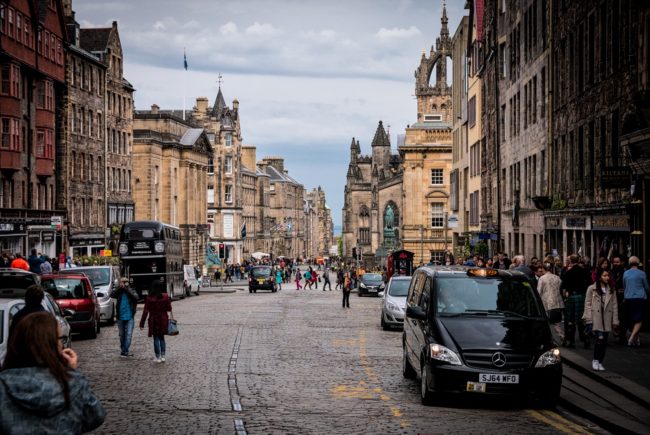 We had already ordered our breakfast for the following morning before we departed for dinner, and it had to be a hearty one because we had a busy (what else is new) day planned. In the morning, we’d head back to the Royal Mile, checking out the castle, some churches, some museums, a Close or two, some whiskey and a visit to the unique, new Parliament building. We’d also check out a graveyard and a tavern dedicated to a dead dog that had probably the funniest hostess we’ve ever encountered anywhere. Tracy and Mary even had time to get some shopping in before we dined at a fantastic little French restaurant. There would be, however, one major site on our day’s agenda that would go unseen thanks to those darned Royals.
We had already ordered our breakfast for the following morning before we departed for dinner, and it had to be a hearty one because we had a busy (what else is new) day planned. In the morning, we’d head back to the Royal Mile, checking out the castle, some churches, some museums, a Close or two, some whiskey and a visit to the unique, new Parliament building. We’d also check out a graveyard and a tavern dedicated to a dead dog that had probably the funniest hostess we’ve ever encountered anywhere. Tracy and Mary even had time to get some shopping in before we dined at a fantastic little French restaurant. There would be, however, one major site on our day’s agenda that would go unseen thanks to those darned Royals.
Next: DAY SIX – Pass The Jam, Gorgeous Garden, Get Those Guards Outta Here, Writer’s Cramp, Is That Dr. Jekyll and Mr. Hyde, Cone Head, It’s In The Bagpipes, Close Encounters, Knox Knox…It’s James’ House, It’s The End Of The World As We Know It, How Much Do We Pay At The Tolbooth, Kirk But No Captain, Controversial Building, Anne Shuts Us Out, Dedicated Dog, More Harry Potter, We Finally Make It In The Castle, The Giant Store and The Best Darned Steak Tartare Ever!

